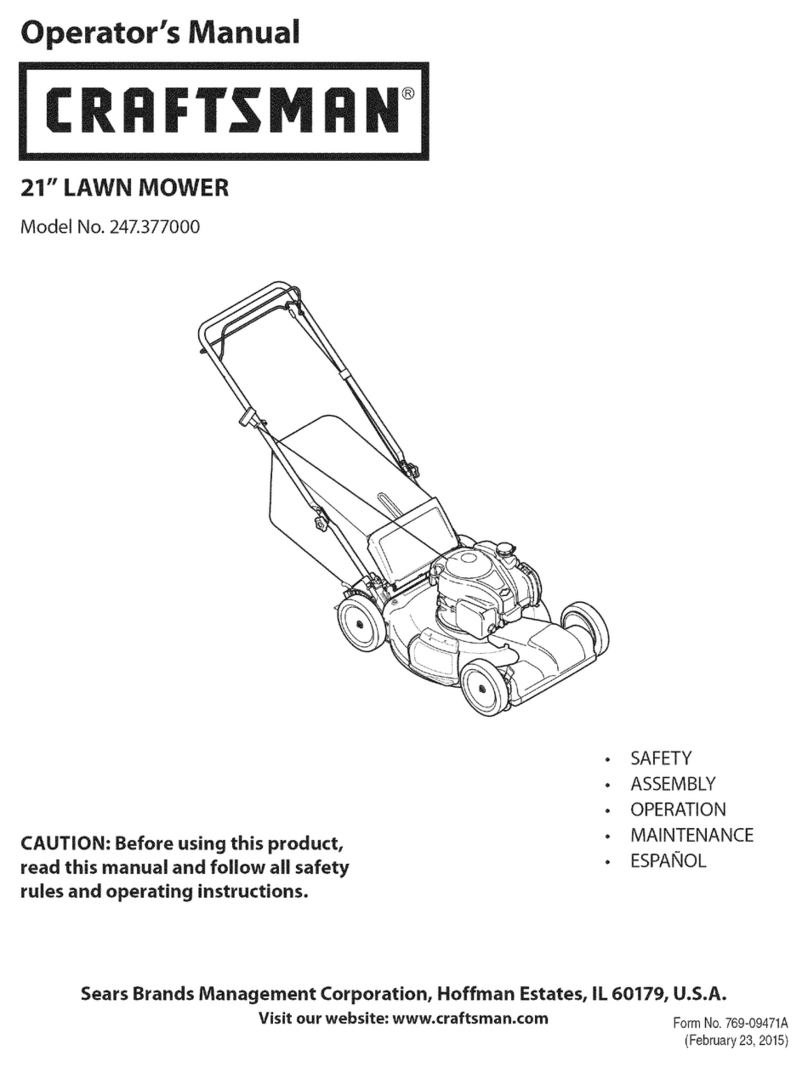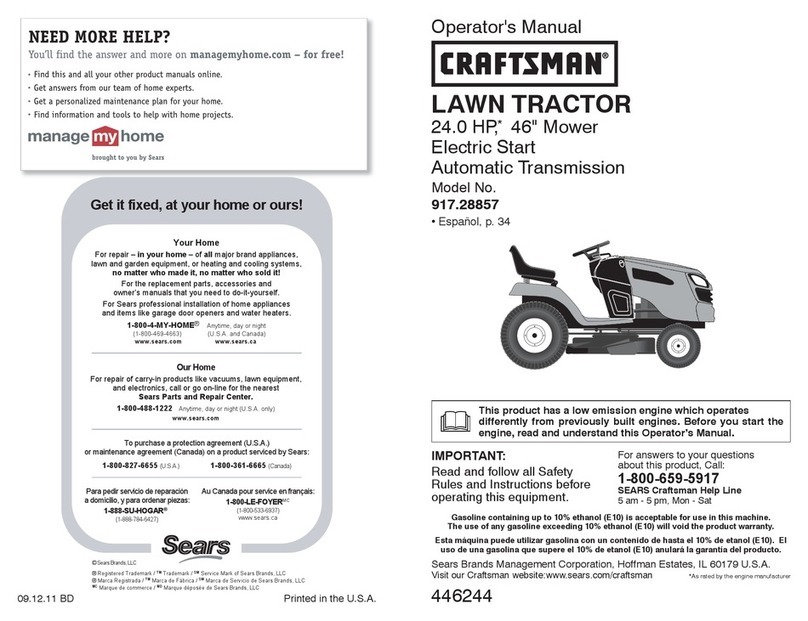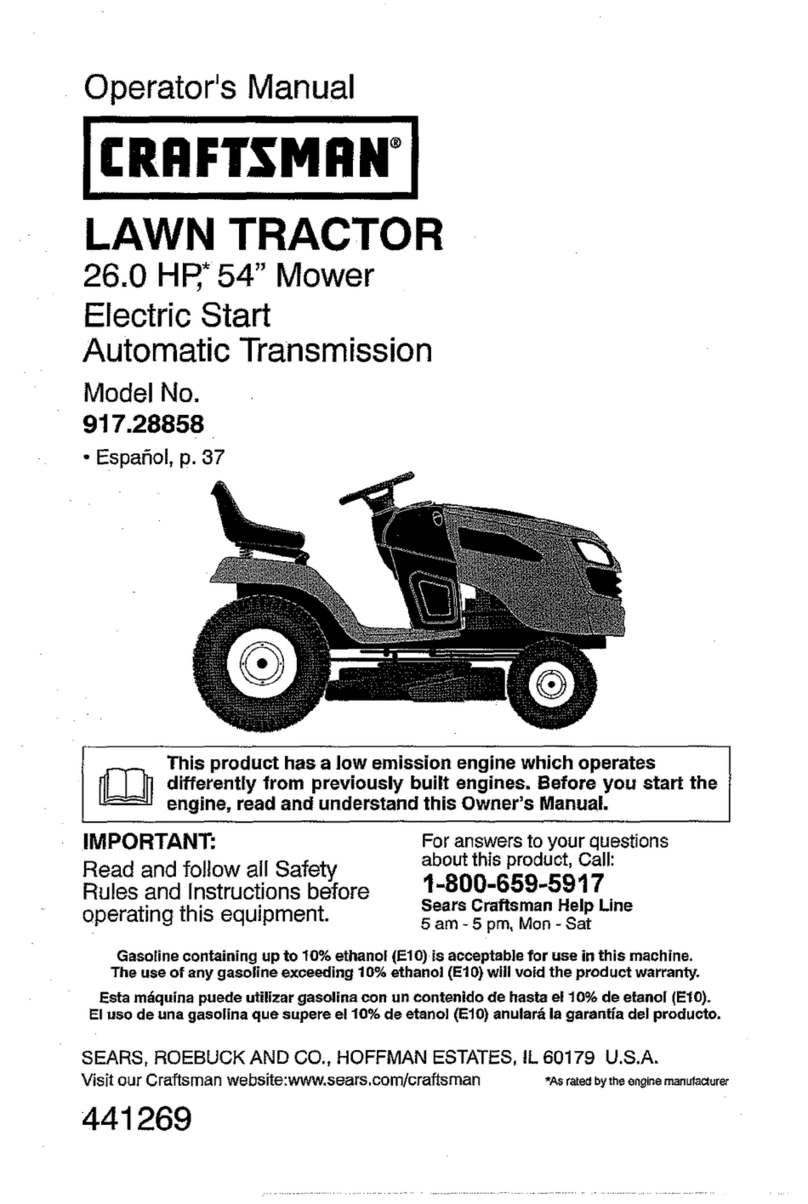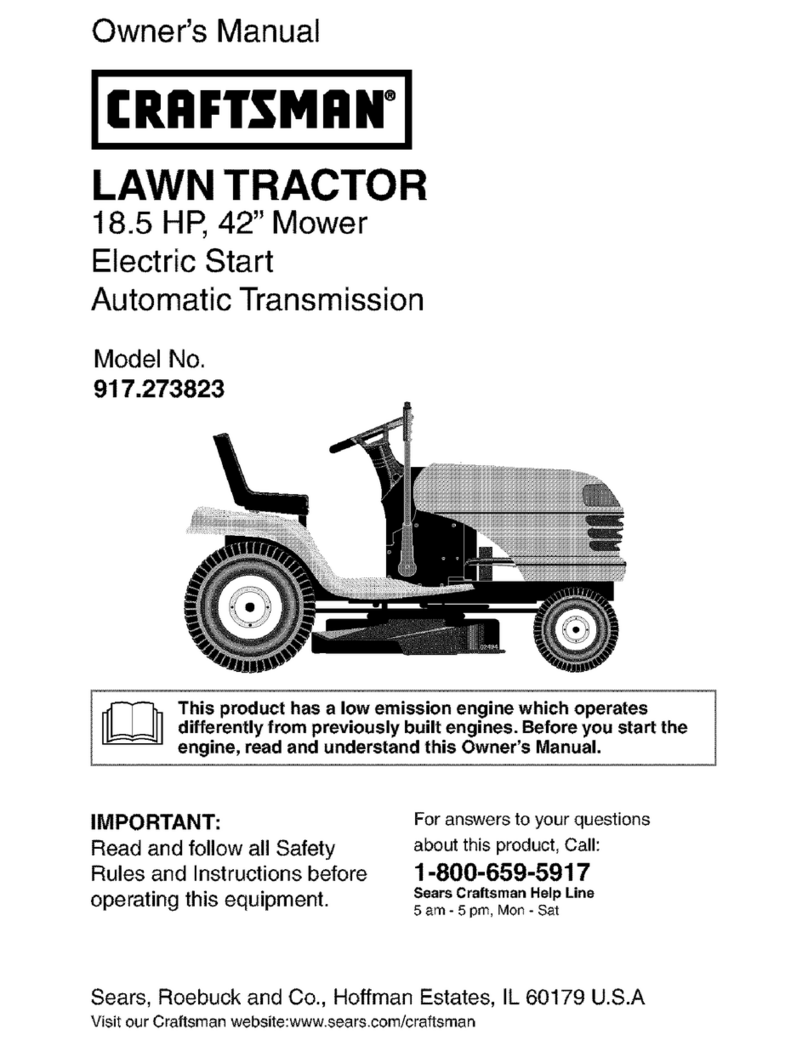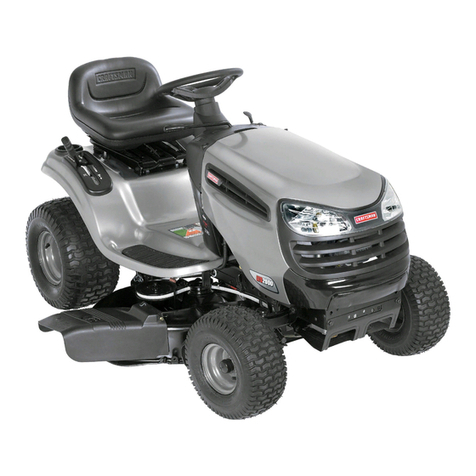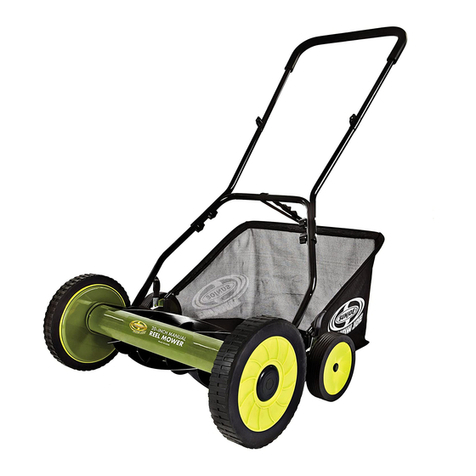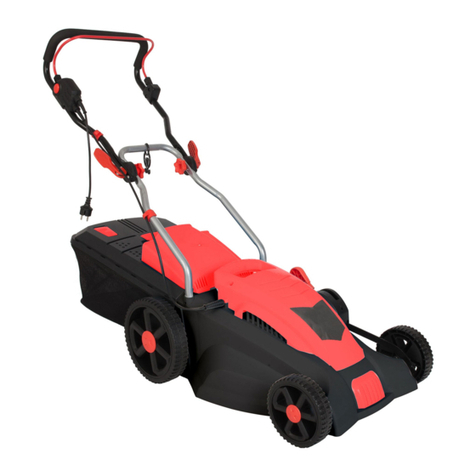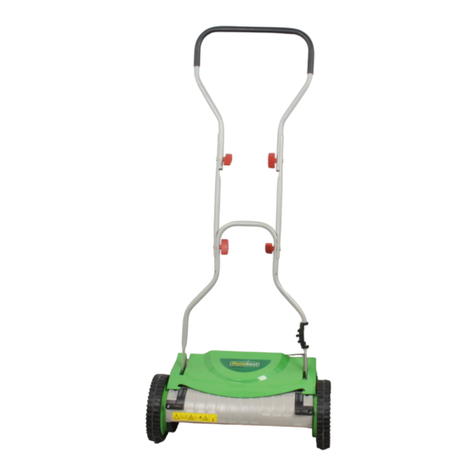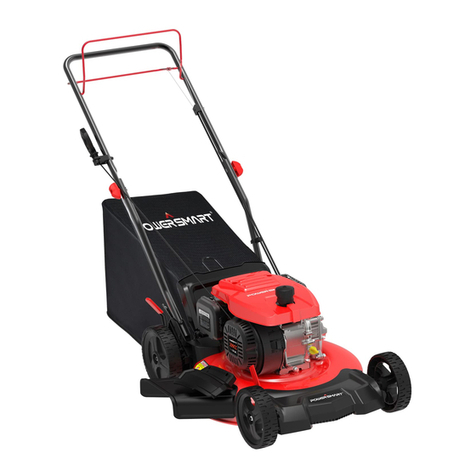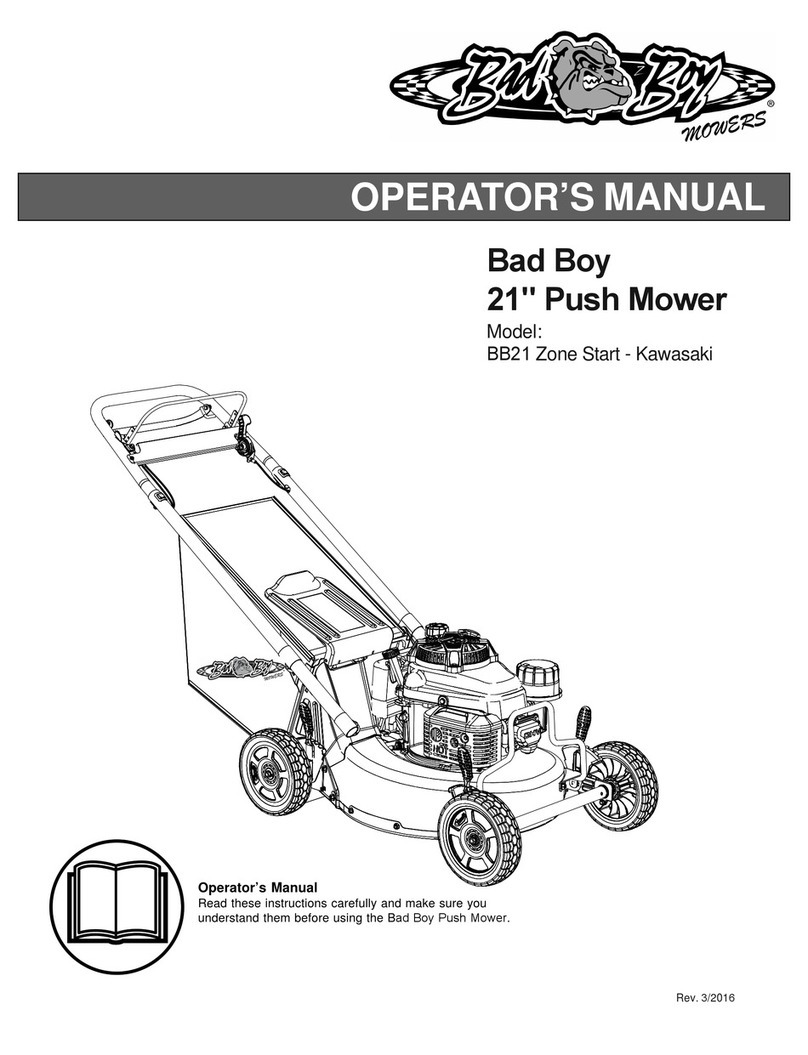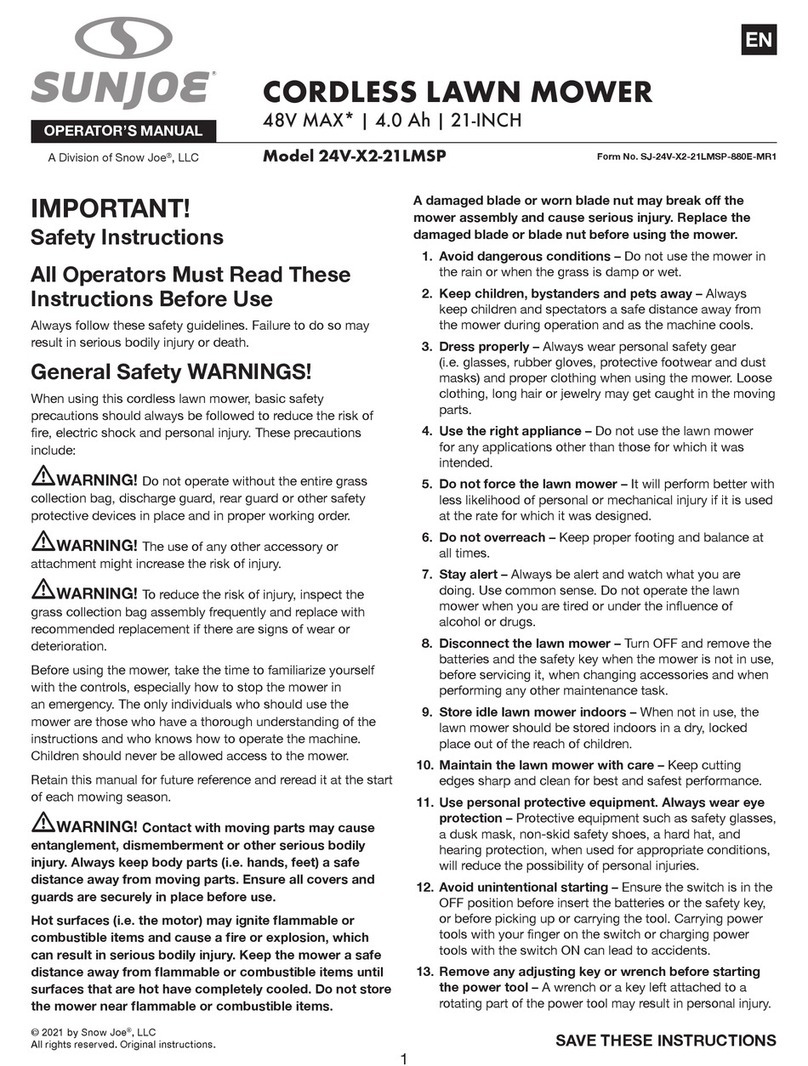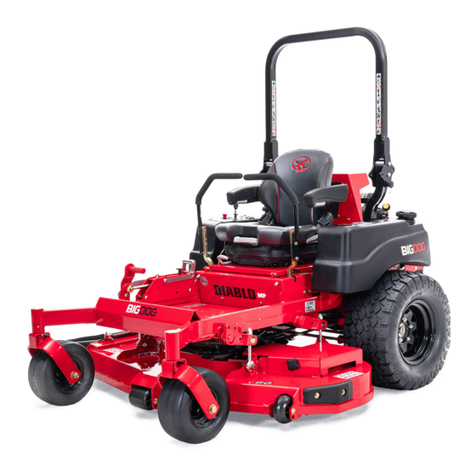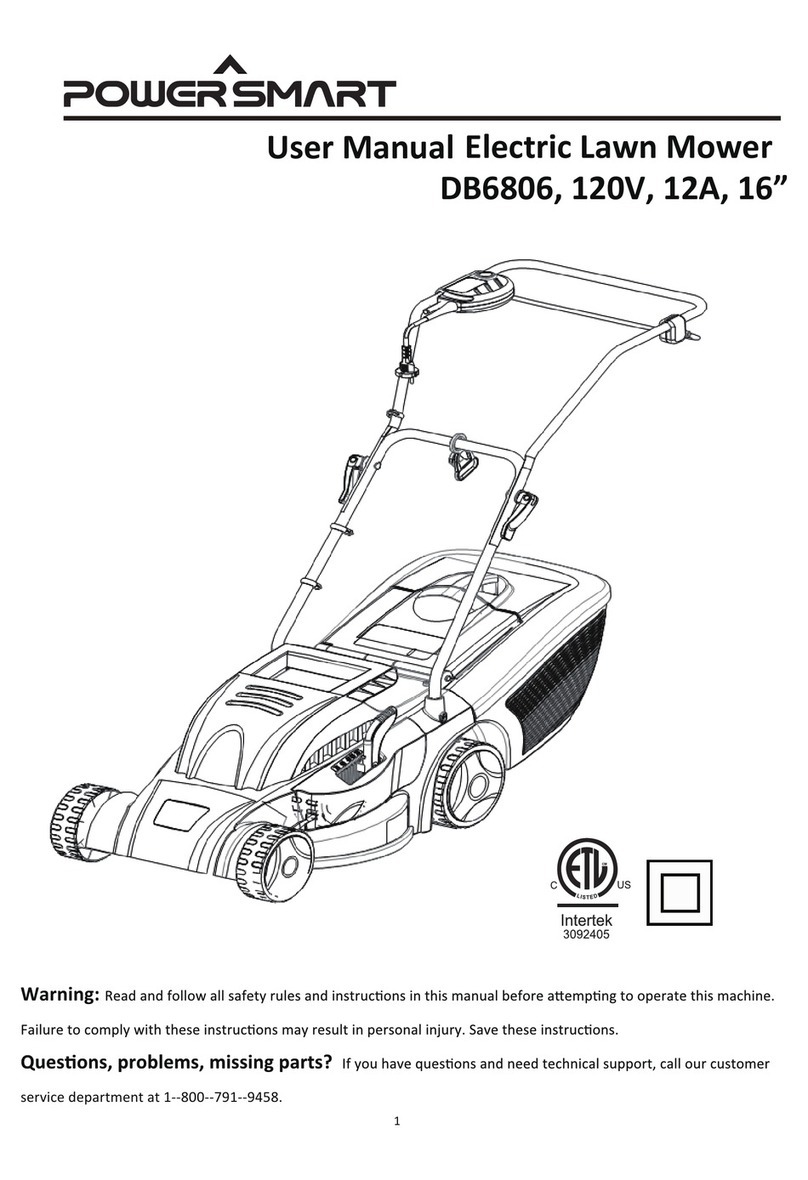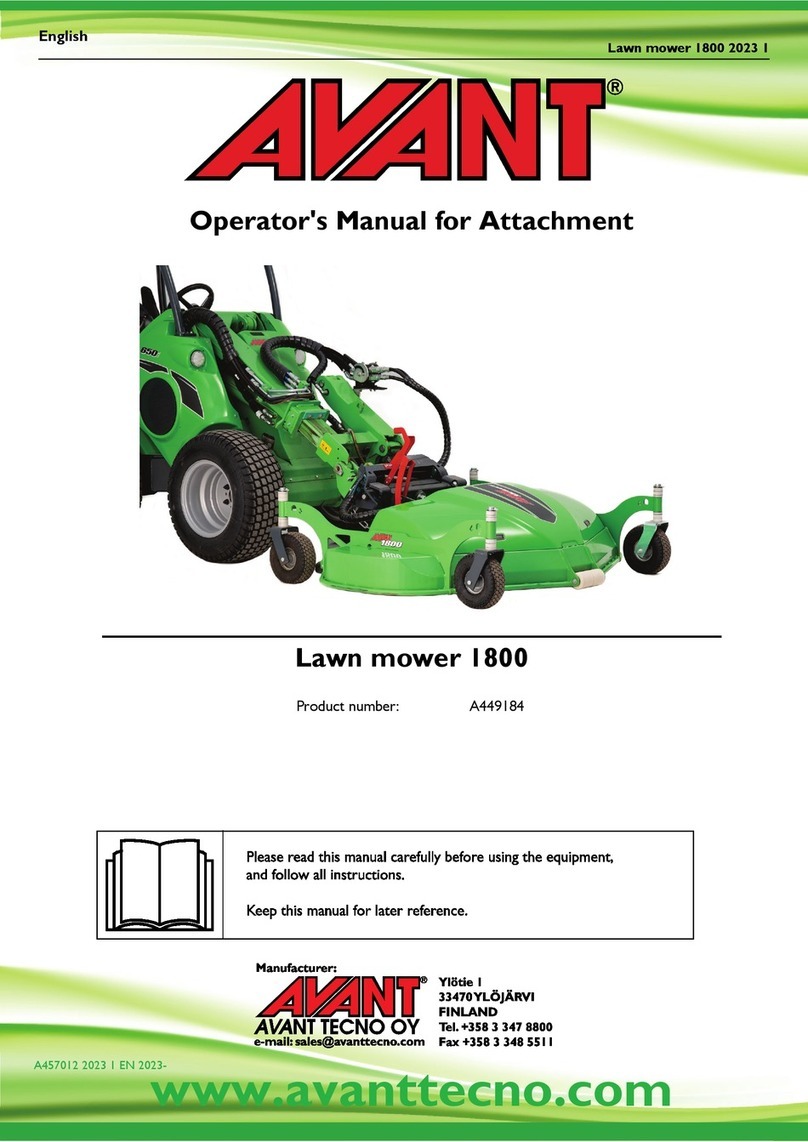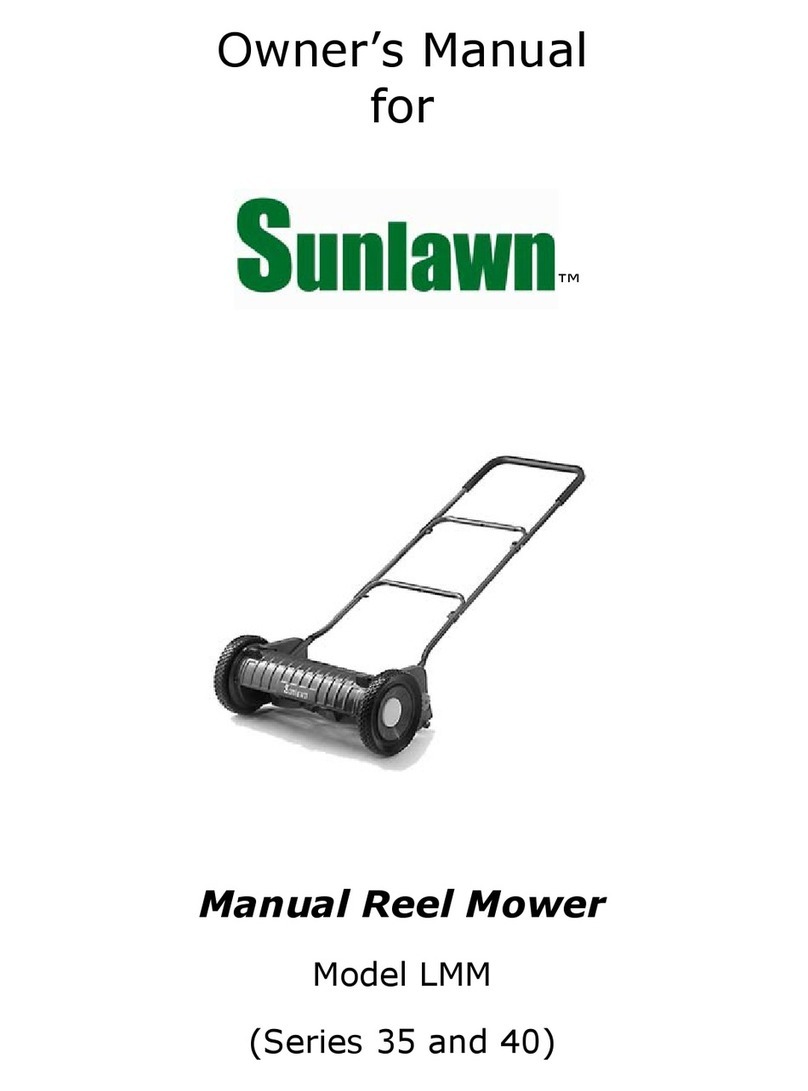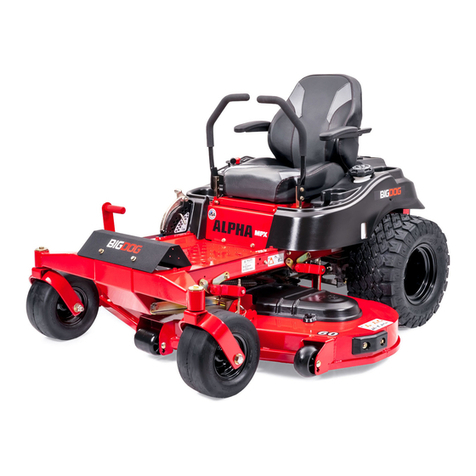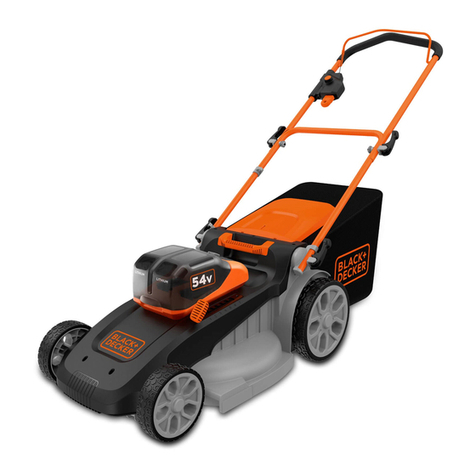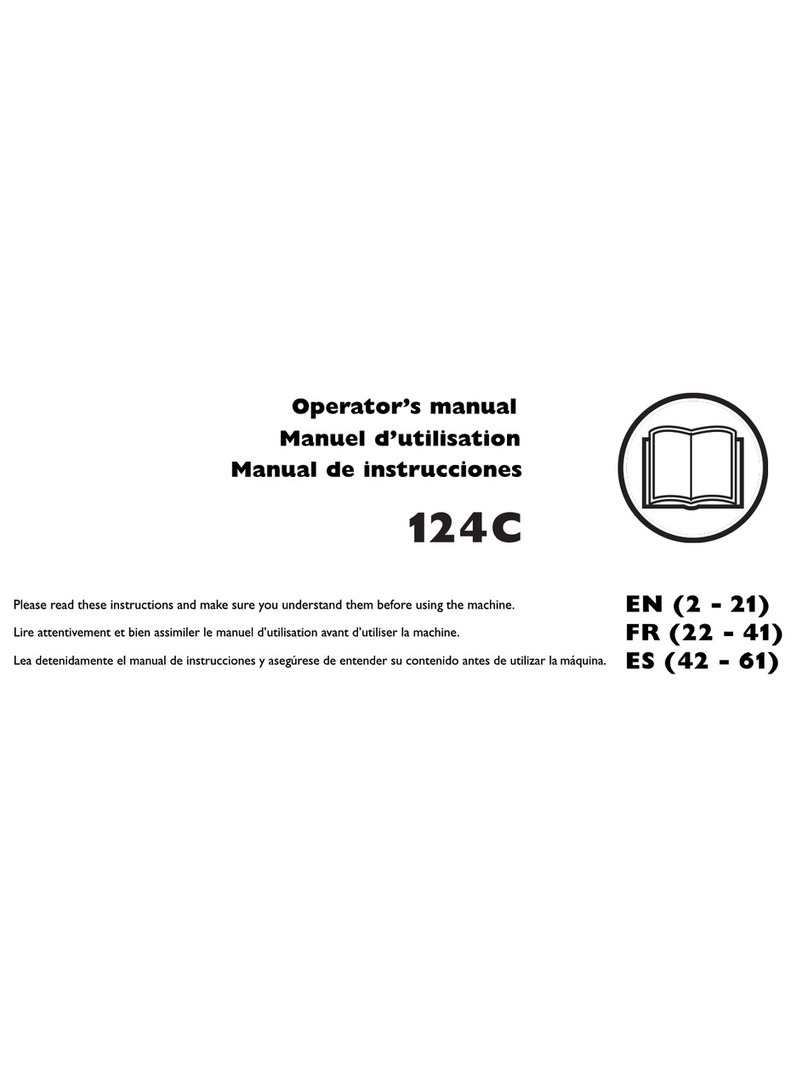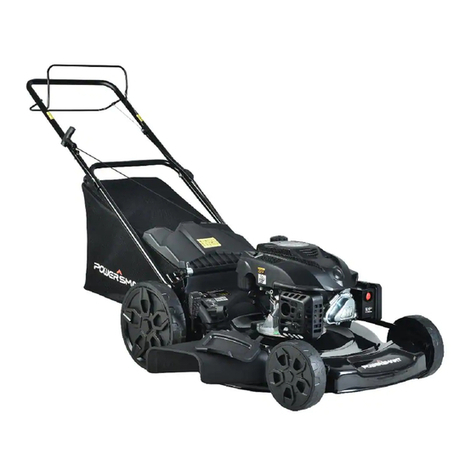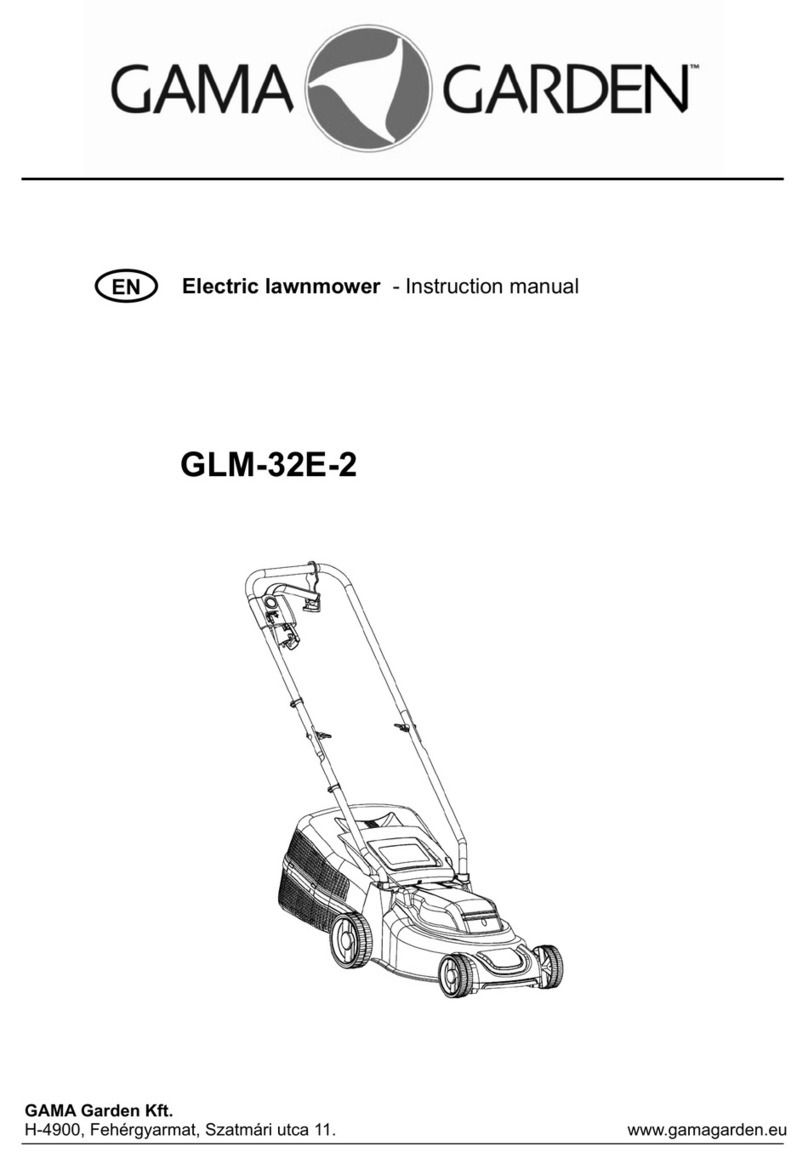Crafstman 917.28861 User manual

Para pedir servicio de reparación
a domicilio, y para ordenar piezas:
1-888-SU-HOGAR®
(1-888-784-6427)
Au Canada pour service en français:
1-800-LE-FOYERMC
(1-800-533-6937)
www.sears.ca
To purchase a protection agreement (U.S.A.)
or maintenance agreement (Canada) on a product serviced by Sears:
1-800-827-6655 (U.S.A.) 1-800-361-6665 (Canada)
Our Home
For repair of carry-in products like vacuums, lawn equipment,
and electronics, call or go on-line for the nearest
Sears Parts and Repair Center.
1-800-488-1222 Anytime, day or night (U.S.A. only)
www.sears.com
Your Home
For repair – in your home – of all major brand appliances,
lawn and garden equipment, or heating and cooling systems,
no matter who made it, no matter who sold it!
For the replacement parts, accessories and
owner’s manuals that you need to do-it-yourself.
For Sears professional installation of home appliances
and items like garage door openers and water heaters.
1-800-4-MY-HOME®Anytime, day or night
(1-800-469-4663) (U.S.A. and Canada)
www.sears.com www.sears.ca
Get it fixed, at your home or ours!
© Sears Brands, LLC
® Registered Trademark / TM Trademark / SM Service Mark of Sears Brands, LLC
® Marca Registrada / TM Marca de Fábrica / SM Marca de Servicio de Sears Brands, LLC
MC Marque de commerce / MD Marque déposée de Sears Brands, LLC
03.08.12 JM Printed in the U.S.A.
IMPORTANT:
Read and follow all Safety
Rules and Instructions before
operating this equipment.
For answers to your questions
about this product, Call:
1-800-659-5917
Sears Craftsman Help Line
5 am - 5 pm, Mon - Sat
Model No.
917.28861
Visit our Craftsman website:www.sears.com/craftsman
• Español, p. 37
GARDEN TRACTOR
26.0 HP,*54” Mower
Electric Start
Automatic Transmission
*As rated by the engine manufacturer
446206 Rev. 1
Gasoline containing up to 10% ethanol (E10) is acceptable for use in this machine.
The use of any gasoline exceeding 10% ethanol (E10) will void the product warranty.
Esta máquina puede utilizar gasolina con un contenido de hasta el 10% de etanol (E10).
El uso de una gasolina que supere el 10% de etanol (E10) anulará la garantía del producto.
Operator's Manual
Sears Brands Management Corporation, Hoffman Estates, IL 60179 U.S.A.
This product has a low emission engine which operates
differently from previously built engines. Before you start the
engine, read and understand this Operator’s Manual.

2
TABLE OF CONTENTS
WARRANTY
Warranty..................................................2
Safety Rules ............................................3
Product Specifications.............................6
Assembly/Pre-Operation .........................8
Operation...............................................13
Maintenance Schedule..........................21
Maintenance..........................................21
Service and Adjustments.......................26
Storage..................................................31
Troubleshooting .....................................32
Sears Service ......................... Back Cover
Craftsman Riding Equipment Warranty
CRAFTSMAN FULL WARRANTY
FOR THREE YEARS from the date of purchase, all non-expendable parts of this riding equipment
are warranted against any defects in material or workmanship. A defective non-expendable part will
receive free in-home repair or replacement if repair is impossible.
FOR FIVE YEARS from the date of purchase, the frame and front axle of this riding equipment are
warranted against any defects in material or workmanship. A defective frame or front axle will receive
free in-home repair or replacement if repair is impossible.
FOR 90 DAYS from the date of purchase, the battery (an expendable part) of this riding equipment
is warranted against any defects in material or workmanship (our testing proves that it will not hold a
charge). A defective battery will receive free in-home replacement.
ADDITIONAL LIFETIME LIMITED WARRANTY on CAST IRON FRONT AXLE (if equipped)
FOR AS LONG AS IT IS USED by the original owner after the fifth year from the date of purchase, the
cast iron front axle (if equipped) of this riding equipment is warranted against any defects in material or
workmanship. With proof of purchase, a defective cast front axle will receive free in-home replacement.
WARRANTY SERVICE
For warranty coverage details to obtain free repair or replacement, call 1-800-659-5917 or visit the
web site: www.craftsman.com
In all cases above, if part repair or replacement is impossible, the riding equipment will be replaced
free of charge with the same or an equivalent model.
All of the above warranty coverage is void if this riding equipment is ever used while providing
commercial services or if rented to another person.
This warranty covers ONLY defects in material and workmanship. Warranty coverage does NOT
include:
• Expendable parts (except battery) that can wear out from normal use within the warranty period,
including but not limited to blades, spark plugs, air cleaners, belts, and oil filters.
• Standard maintenance servicing, oil changes, or tune-ups.
• Tire replacement or repair caused by punctures from outside objects, such as nails, thorns,
stumps, or glass.
• Tire or wheel replacement or repair resulting from normal wear, accident, or improper operation or
maintenance.
• Repairs necessary because of operator abuse, including but not limited to damage caused by
towing objects beyond the capability of the riding equipment, impacting objects that bend the
frame, axle assembly or crankshaft, or over-speeding the engine.
• Repairs necessary because of operator negligence, including but not limited to, electrical and
mechanical damage caused by improper storage, failure to use the proper grade and amount
of engine oil, failure to keep the deck clear of flammable debris, or failure to maintain the riding
equipment according to the instructions contained in the operator’s manual.
• Engine (fuel system) cleaning or repairs caused by fuel determined to be contaminated or oxidized
(stale). In general, fuel should be used within 30 days of its purchase date.
• Normal deterioration and wear of the exterior finishes, or product label replacement.
This warranty gives you specific legal rights, and you may also have other rights which vary from
state to state.
Sears Brands Management Corporation, Hoffman Estates, IL 60179
71
15 GRADOS MAX.
PLEGAR A LO LARGO DE LA LÍNEA PUNTEADA
ESTA ES UNA PENDIENTE DE 15 GRADOS
SOLAMENTE ANDE CUESTA ARRIBA O
CUESTA ABAJO Y NO ATRAVIESE EL CERRO
GUÍA SUGERIDA PARA MEDIR LAS PENDIENTES CON LA VISTA PARA UNA
OPERACIÓN SEGURA
ADVERTENCIA: Para evitar daños graves, haga funcionar su tractor arriba
y abajo de las pendientes, nunca transversalmente con respecto a las
pendientes. No cortar pendientes mayores de 15 grados. Haga los
virajes gradualmente para evitar volcarse o la pérdida de control.
Tenga mucho cuidado cuando cambie de dirección en las pendientes.
1. Plegar esta página a lo largo de la línea punteada arriba indicada.
2. Tener la página ante de sí mismos de modo que su borde izquierdo sea vertical
paralelo al tronco del árbol u otra estructura vertical.
3. Mirar a través del pliegue en dirección de la pendiente que se quiere medir.
4. Comparar el ángulo del pliegue con la pendiente del terreno.

70
NOTES/AVISO
3
I. GENERAL OPERATION
• Read, understand, and follow all instruc-
tions on the machine and in the manual
before starting.
• Do not put hands or feet near rotating
parts or under the machine. Keep clear
of the discharge opening at all times.
• Only allow responsible adults, who are
familiar with the instructions, to operate
the machine.
• Clear the area of objects such as rocks,
toys, wire, etc., which could be picked
up and thrown by the blades.
• Be sure the area is clear of bystanders
beforeoperating. Stopmachine ifanyone
enters the area.
• Never carry passengers.
• Do not mow in reverse unless absolutely
necessary. Alwayslook downandbehind
before and while backing.
• Never direct discharged material toward
anyone. Avoid discharging material
against a wall or obstruction. Material
may ricochet back toward the operator.
Stop the blades when crossing gravel
surfaces.
• Do not operate machine without the en-
tire grass catcher, discharge chute, or
othersafetydevices inplaceand working.
• Slow down before turning.
• Never leave a running machine unat-
tended. Always turn off blades, set
parking brake, stop engine, and remove
keys before dismounting.
• Disengage blades when not mowing.
Shut off engine and wait for all parts to
come to a complete stop before cleaning
themachine, removingthegrass catcher,
or unclogging the discharge chute.
• Operatemachine onlyin daylightor good
artificial light.
• Do not operate the machine while under
the influence of alcohol or drugs.
• Watch for traffic when operating near or
crossing roadways.
• Useextra carewhenloading orunloading
the machine into a trailer or truck.
• Alwayswear eyeprotectionwhen operat-
ing machine.
• Data indicates that operators, age 60
years and above, are involved in a large
percentage of riding mower-related inju-
ries. These operators should evaluate
their ability to operate the riding mower
safely enough to protect themselves and
others from serious injury.
• Followthemanufacturer’s recommenda-
tionfor wheelweights orcounterweights.
• Keep machine free of grass , leaves or
otherdebris build-upwhich cantouch hot
exhaust / engine parts and burn. Do not
allow the mower to plow leaves or other
debris which can cause build-up to oc-
cur. Clean any oil or fuel spillage before
operating or storing the machine. Allow
machine to cool before storage.
DANGER: This cutting machine is capable of amputating hands and feet and
throwing objects. Failure to observe the following safety instructions could result
in serious injury or death.
WARNING: In order to prevent acciden-
tal starting when setting up, transporting,
adjusting or making repairs, always discon-
nect spark plug wire and place wire where
it cannot contact spark plug.
WARNING: Do not coast down a hill in
neutral, you may lose control of the tractor.
WARNING: Tow only the attachments
that are recommended by and comply with
specifications of the manufacturer of your
tractor. Use common sense when towing.
Operate only at the lowest possible speed
when on a slope. Too heavy of a load, while
on a slope, is dangerous. Tires can lose
traction with the ground and cause you to
lose control of your tractor.
WARNING: Engine exhaust, some of
its constituents, and certain vehicle compo-
nents contain or emit chemicals known to
the State of California to cause cancer and
birth defects or other reproductive harm.
WARNING: Battery posts, terminals and
related accessories contain lead and lead
compounds,chemicals knowntothe Stateof
California to cause cancer and birth defects
or other reproductive harm. Wash hands
after handling.
SAFETY RULES

4
II. SLOPE OPERATION
Slopes are a major factor related to loss of
control and tip-over accidents, which can
result in severe injury or death. Operation
on all slopes requires extra caution. If you
cannotback uptheslope orif youfeeluneasy
on it, do not mow it.
• Mow up and down slopes, not across.
• Watch for holes, ruts, bumps, rocks, or
other hidden objects. Uneven terrain
could overturn the machine. Tall grass
can hide obstacles.
• Choose a low ground speed so that you
will not have to stop or shift while on the
slope.
• Do not mow on wet grass. Tires may lose
traction.
Always keep the machine in gear when
goingdown slopes.Do notshift toneutral
and coast downhill.
• Avoid starting, stopping, or turning on a
slope. Ifthe tireslosetraction, disengage
the blades and proceed slowly straight
down the slope.
• Keep all movement on the slopes slow
and gradual. Do not make sudden
changes in speed or direction, which
could cause the machine to roll over.
• Use extra care while operating machine
withgrass catchersorother attachments;
they can affect the stability of the ma-
chine. Do no use on steep slopes.
• Do not try to stabilize the machine by
putting your foot on the ground.
• Do not mow near drop-offs, ditches,
or embankments. The machine could
suddenly roll over if a wheel is over the
edge or if the edge caves in.
III. CHILDREN
WARNING: CHILDREN CAN BE INJURED
BY THIS EQUIPMENT. The American Acade-
my of Pediatrics recommends that children
be a minimum of 12 year of age before op-
erating a pedestrian controlled lawn mower
and a minimum of 16 years of age before
operating a riding lawn mower.
Tragic accidents can occur if the operator
is not alert to the presence of children.
Children are often attracted to the machine
and the mowing activity. Never assume
that children will remain where you last
saw them.
• Keep children out of the mowing area
and in the watchful care of a responsible
adult other than the operator.
• Be alert and turn machine off if a child
enters the area.
• Before and while backing, look behind
and down for small children.
• Nevercarrychildren, evenwiththe blades
shutoff. Theymayfall offandbe seriously
injured or interfere with safe machine
operation.Children whohave beengiven
rides in the past may suddenly appear in
the mowing area for another ride and be
run over or backed over by the machine.
• Never allow children to operate the ma-
chine.
• Use extra care when approaching blind
corners, shrubs, trees, or other objects
that may block your view of a child.
IV. TOWING
• Tow only with a machine that has a hitch
designedfor towing. Donot attachtowed
equipment except at the hitch point.
• Followthemanufacturer’s recommenda-
tionfor weight limitsfor towedequipment
and towing on slopes.
• Never allow children or others in or on
towed equipment.
• Onslopes, theweight ofthe towedequip-
ment may cause loss of traction and loss
of control.
• Travel slowly and allow extra distance to
stop.
V. SERVICE
SAFE HANDLING OF GASOLINE
To avoid personal injury or property dam-
age, use extreme care in handling gasoline.
Gasoline is extremely flammable and the
vapors are explosive.
• Extinguish all cigarettes, cigars, pipes,
and other sources of ignition.
• Use only approved gasoline container.
• Never remove gas cap or add fuel with
the engine running. Allow engine to cool
before refueling.
• Never fuel the machine indoors.
• Neverstore themachineor fuelcontainer
where there is an open flame, spark, or
pilot light such as on a water heater or
other appliances.
• Never fill containers inside a vehicle or
on a truck or trailer bed with plastic liner.
Always place containers on the ground
away from your vehicle when filling.
SAFETY RULES
69
IDENTIFICACIÓN DE PROBLEMAS:
Vea la sección apropiada en el manual a menos que esté dirigido a un centro de servicio
Sears.
PROBLEMA CAUSA CORRECCIÓN
Las luz (ces)
de lantera(s)
no funciona-
ndo
1. El interruptor está “APAGADO”(OFF). 1. “ENCIENDA” (ON) el interruptor.
2. Bombilla(s) o lámpara(s) quemada(s). 2.
Cambie la bombilla(s) o lámpara(s).
3. Interruptor de la luz fallado. 3. Revise/cambie el interruptor de la luz.
4. Alambrado suelto o dañado. 4.
Revise el alambrado y las conexiones.
5. Fusible quemado. 5. Cambie el fusible.
La batería
no carga
1.
Elemento(s) de la batería malo(s).
1. Cambie la batería.
2.
Malas conexiones de cables.
2. Revise/limpie todas las cables.
3. Regulador fallado (si equipado). 3. Cambie el regulador.
4. Alternador fallado. 4. Cambie el alternador.
Pérdida de
impulsión
1. El control de rueda libre está enla posición
“DESENGANCHADO” (disengaged). 1. Ponga el control de rueda libre enla
posición “ENGANCHADO”(disengaged).
2. Residuos es en de la placa de dirección
(Si los tiene). 2. Vea “LIMPIEZA” en la sección de Manteni-
mento de este manual.
3. La correa de impulsión de impulsión de
movimiento. 3. Reemplace la correa de movimien-to esta
gastada, dañada o rota.
4. Aireatrapado en la transporte o el servicio. 4. Purgue la transmisión.
5. Llave cuadrada de eje es ausente. 5. Vea “PARA REMOVER LAS RUEDAS”
en la sección de Servicio y Ajustes de
este manual.
El motor tien
“contraex-
plosiones”
cuando se
“APAGA”
1. Elcontroldelaaceleracióndel motor no fue
ajustadoenlaposicióndevelocidadmedia
y máxima (rápida) antes de para el motor.
1. Mueva el control de la aceleración a la
posición de velocidad media y máxima
(rápida) antes de para el motor.
El tractor se
ponen mar-
cha atrás
1. El sistema de funcionamiento atrás (ROS)
no está "ON", cuando enganche la sega-
dora o otro accesorio.
1. Girar el ROS en la posición "ON".Vea la
sección de operación.

68
IDENTIFICACIÓN DE PROBLEMAS:
Vea la sección apropiada en el manual a menos que esté dirigido a un centro de servicio
Sears.
PROBLEMA CAUSA CORRECCIÓN
Pérdida de
fuerza
(sigue)
9. Agua en el combustible. 9. Vaciarelestanquedecombustibleyelcarbu-
rador,vuelvaallenarelestanque con gaso-
linanuevaycambieelfiltro de combustible.
10. Alambrado de la bujía suelto. 10. Conecte y apriete el alambre de la bujía.
11. Rejilla/aletas de aire del motor sucias. 11. Limpie las rejilla/aletas de aire del motor.
12. Silenciador sucio/taponado. 12. Limpie/cambie el silenciador.
13. Alambrado suelto o dañado. 13. Revise todo el alambrado.
14. Carburador desajustado. 14. Vea “PARAAJUSTAR EL CARBURADOR”
en la sección de Servicio y Ajustes.
15. Válvulas del motor desajustadas. 15. Pongase en contacto con un centro de
servicio cualificado "SEARS".
Vibración
excesiva
1. Cuchilla desgastada, doblada o suelta. 1. Cambie la cuchilla. Apriete el perno de
la cuchilla.
2. Mandril de la cuchilla doblado. 2. Cambie la mandril de la cuchilla.
3. Parte(s) suelta(s)/dañada(s). 3. Apriete la(s) parte(s). Cambie las partes
dañadas.
El motor conti-
núa funcionando
cuando el op-
erador se baja
delasientocon
el embrague
del accesorio
enganchado
1. Sistema de control que exige la presencia
del operador –seguridad fallado. 1. Revise el alambrado, los interruptores
y la conexiones.Si no están correctas,
Pongase en contacto con un centro de
servicio cualificado "SEARS".
El corte
disparejo
1. Cuchilla desgastada, doblada o suelta. 1. Cambie la cuchilla. Apriete el perno de
la cuchilla.
2. El conjunto segador no estánivelado. 2. Nivele el conjunto segador.
3. Acumulación de césped, hojas y basura
debajo de la segadora. 3. Limpie la parte inferior de la cajade la
segadora.
4. Mandril de la cuchilla doblado. 4. Cambie la mandril de la cuchilla.
5. Los agujeros de ventilación del conjunto
segador taponadosdebido a la acumu-
lación de
cé-sped, hojas y basura
alred-
edorde los mandriles.
5. Limpie alrededor de los mandriles para
abrir los de ventilación.
Las cuchil-
las segado-
ras no rotan
1. Obstrucciónenelmecanismodelembrague. 1. Remueva la obstrucción.
2. Lacorreadeimpulsióndelasegadoraestá
desgastada/dañada. 2. Cambie la correa de impulsión de la
segadora.
3. Polea de guía atascada. 3. Cambie la polea de guía.
4. Mandril de la cuchilla atascado. 4. Cambie la mandril de la cuchilla.
Mala des-
carga del
césped
1. Velocidad del motor muy lenta. 1. Ponga el control de la aceleración en la
posición de “RÁPIDO” (fast).
2. Velocidad de recorrido demasiado rápida. 2. Cambie a una velocidad más lenta.
3. Césped mojado. 3. Permita que se seque el céspedantes
de segar.
4. El conjunto segador no estánivelado. 4. Nivele el conjunto segador.
5. Presión de aire de las llantas baja o
dispareja. 5. Revise las llantas para verificarque tienen
la presión de aire.
6. Cuchilla desgastada, doblada o suelta. 6. Cambie/afile la cuchilla. Apriete el perno
de la cuchilla.
7. Acumulación de césped, hojas y basura
debajo de la segadora. 7. Limpie la parte inferior de la cajade la
segadora.
8. Lacorreadeimpulsióndelasegadoraestá
desgastada o desajustada. 8. Cambie/ajuste la correa de impulsión de
la segadora.
9. Las cuchillas están mal coninstaladas. 9.
Vuelva a instalar las cuchillas elborde afilado
hacia abajo.
10. Cuchillas inadecuadas en uso. 10. Cambie por las cuchillas enumeradas en
este manual.
11. Los agujeros de ventilación del conjunto
agujeros segador taponados debido a la
acumulación de césped, hojas y basura
alrededor de los mandriles.
11. Limpie alrededor de los mandriles para
abrir los de ventilación.
5
• Remove gas-powered equipment from
the truck or trailer and refuel it on the
ground. If this is not possible, then refuel
suchequipmentwith aportablecontainer,
rather than from a gasoline dispenser
nozzle.
• Keep the nozzle in contact with the rim
of the fuel tank or container opening at
all times until fueling is complete. Do not
use a nozzle lock-open device.
• Iffuel is spilledon clothing,change cloth-
ing immediately.
• Never overfill fuel tank. Replace gas cap
and tighten securely.
GENERAL SERVICE
• Never operate machine in a closed area.
• Keepallnuts andbolts tightto besure the
equipment is in safe working condition.
• Maintainor replacesafetyand instruction
labels, as necessary.
• Be sure the area is clear of bystanders
beforeoperating. Stopmachine ifanyone
enters the area.
• Never carry passengers.
• Do not mow in reverse unless absolutely
necessary.Always lookdownand behind
before and while backing.
• Never carry children, even with the
blades shut off. They may fall off and
be seriously injured or interfere with safe
machine operation. Children who have
beengivenrides inthepast maysuddenly
appear in the mowing area for another
ride and be run over or backed over by
the machine.
• Keep children out of the mowing area
and in the watchful care of a responsible
adult other than the operator.
• Nevertamper withsafety devices.Check
their proper operation regularly.
• Keep machine free of grass, leaves, or
other debris build-up. Clean oil or fuel
spillageand removeany fuel-soakedde-
bris. Allowmachineto coolbeforestoring.
• If you strike a foreign object, stop and
inspectthemachine. Repair, ifnecessary,
before restarting.
• Never make any adjustments or repairs
with the engine running.
• Checkgrasscatcher componentsandthe
discharge chute frequently and replace
withmanufacturer’srecommended parts,
when necessary.
• Mowerblades aresharp. Wrap theblade
or wear gloves, and use extra caution
when servicing them.
• Checkbrake operationfrequently. Adjust
and service as required.
• Be alert and turn machine off if a child
enters the area.
• Before and while backing, look behind
and down for small children.
• Mow up and down slopes (15° Max), not
across.
• Choose a low ground speed so that you
will not have to stop or shift while on the
slope.
• Avoid starting, stopping, or turning on a
slope. Ifthe tireslosetraction, disengage
the blades and proceed slowly straight
down the slope.
• If machine stops while going uphill,
disengage blades, shift into reverse and
back down slowly.
• Do not turn on slopes unless necessary,
and then, turn slowly and gradually
downhill, if possible.
• Whenloading orunloading thismachine,
do not exceed the maximum recom-
mended operation angle of 15°.
SAFETY RULES

6
CUSTOMER RESPONSIBILITIES
• Read and observe the safety rules.
• Follow a regular schedule in maintaining,
caring for and using your tractor.
• Follow instructions under “Maintenance”
and “Storage” sections of this manual.
• Wear proper Personal Protective Equip-
ment (PPE) while operating this machine,
including (at a minimum) sturdy footwear,
eye protection, and hearing protection.
Do not mow in shorts and/or open toed
footwear.
• Alwayslet someoneknow you areoutside
mowing.
WARNING: Thistractor isequipped with
an internal combustion engine and should
not be used on or near any unimproved
forest-covered, brush-covered or grass-
covered land unless the engine’s exhaust
system is equipped with a spark arrester
meeting applicable local or state laws (if
any). If a spark arrester is used, it should
be maintained in effective working order by
the operator.
CONGRATULATIONS on yourpurchase of
a new tractor. It has been designed, engi-
neeredandmanufacturedto giveyouthebest
possible dependability and performance.
Shouldyouexperience anyproblemyou can-
not easily remedy, please contact a Sears or
otherqualified servicecenter. Wehavecom-
petent, well-trained representatives and the
proper tools to service or repair this tractor.
Please read and retain this manual. The
instructions will enable you to assemble
and maintain your tractor properly. Always
observe the “SAFETY RULES”.
Inthe stateofCalifornia theabove isrequired
by law (Section 4442 of the California Public
Resources Code). Other states may have
similar laws. Federal laws apply on federal
lands. A spark arrester for the muffler is
availablethrough yournearestSears service
center (See REPAIR PARTS manual).
REPAIR PROTECTION AGREEMENTS
Congratulations on making a smart pur-
chase. Your new Craftsman® product is
designed and manufactured for years of
dependable operation. But like all products,
itmay requirerepair from timeto time.That’s
whenhaving aRepair ProtectionAgreement
can save you money and aggravation.
Purchase a Repair Protection Agreement
now and protect yourself from unexpected
hassle and expense.
Here’s what’s included in the Agreement:
• Expertserviceby our12,000professional
repair specialists.
• Unlimitedservice andno chargefor parts
and labor on all covered repairs.
• Product replacement if your covered
product can’t be fixed.
• Discount of 10% from regular price of
service and service-related parts not
covered by the agreement; also, 10% off
regular price of preventive maintenance
check.
• Fast help by phone – phone support
from a Sears representative on products
requiringin-home repair, plusconvenient
repair scheduling.
Onceyou purchasethe Agreement,asimple
phone call is all that it takes for you to sched-
uleservice. Youcan callanytime dayornight,
or schedule a service appointment online.
Sears has over 12,000 professional repair
specialists, who have access to over 4.5
million quality parts and accessories. That’s
thekind of professionalismyou cancounton
to help prolong the life of your new purchase
for years to come. Purchase your Repair
Protection Agreement today!
Some limitations and exclusions apply.
Forpricesand additionalinformation call
1-800-827-6655.
SEARS INSTALLATION SERVICE
For Sears professional installation of home
appliances, garage door openers, water
heaters, and other major home items, in the
U.S.A. call 1-800-4-MY-HOME®
PRODUCT SPECIFICATIONS
Gasoline Capacity
and type: 4.0 Gallons/15,14 L
Regular Unleaded
Oil Type:
(API: SG-SL) SAE30 (above 32°F/0°C)
SAE 5W30 (below 32°F/0°C)
Oil Capacity: 64 Oz./1,96 L
Spark Plug: Champion RC12YC
(Gap: .030"/0.76 mm)
Ground Speed
(Mph/Kph): Forward: 0 - 7.8/12,5
Reverse: 0 - 2.9/4,7
Charging
System: 15 amps @ 3600 rpm
Battery: Amp/Hr: 28
Min. CCA: 230
Case size: U1R
Blade Bolt Torque: 45-55 Ft. Lbs./62-75 Nm
67
IDENTIFICACIÓN DE PROBLEMAS:
Vea la sección apropiada en el manual a menos que esté dirigido a un centro de servicio Sears.
PROBLEMA CAUSA CORRECCIÓN
No arranca 1. Sin combustible. 1. Llene el estanque de combustible.
2. Motor sin la “ESTRANGULACIÓN”
(CHOKE) adecuada. 2. Vea “PARA HACER ARRANCAR EL MO-
TOR” en la sección de operación.
3. Motor ahogado. 3. Espere varios minutos antes detratar de
arrancar.
4. Bujía mala. 4. Cambie la bujía.
5. Filtro de aire sucio. 5. Limpie/cambie el filtro de aire.
6. Filtro de combustible sucio. 6. Cambie el filtro de combustible.
7. Agua en el combustible. 7. Vaciar el estanque de combustible y el
carburador, vuelva a llenar el estanque
con gasolina nueva cambie el filtro de
combustible.
8. Alambrado suelto o dañado. 8. Revise todo el alambrado.
9. Carburador desajustado. 9.
Vea “PARA AJUSTAR
EL CARBURADOR”
en la sección de Servicio y Ajustes.
10. Válvulas del motor desajustadas. 10. Pongase en contacto con un centro de
servicio cualificado "SEARS".
Difícil de
arrancar
1. Filtro de aire sucio. 1. Limpie/cambie el filtro de aire.
2. Bujía mala. 2. Cambie la bujía.
3. Batería baja o descargada. 3.
Vuelva a cargar o cambie la batería.
4. Filtro de combustible sucio. 4. Cambie el filtro de combustible.
5. Combustible rancio o sucio. 5. Vaciar elestanquedecombustibleyvuelva
a llenarlo con gasolina nueva.
6. Alambrado suelto o dañado. 6. Revise todo el alambrado.
7. Carburador desajustado. 7. Vea “PARAAJUSTAR EL CARBURADOR”
en la sección de Servicio y
Ajustes.
8.
Válvulas del
motor desajustadas. 8. Pongase en contacto con un centro de
servicio cualificado "SEARS".
El motor no
la vuelta
1. Pedal del freno no presionado. 1. Presione el pedal del freno.
2. Elembraguedelaccesorioestáenganchado. 2. Desenganche el embrague del accesorio.
3. Batería baja o descargada. 3.
Vuelva a cargar o cambie la batería.
4. Fusible quemado. 4. Cambie el fusible.
5.
Terminales de la batería corroídos.
5. Limpie los terminales de la batería.
6. Alambrado suelto o dañado. 6. Revise todo el alambrado.
7. Interruptor de la ignición fallado. 7. Revise/cambieelinterruptordelaignición.
8. Solenoide o arrancador fallados. 8. Revise/cambie el solenoide o arrancador.
9. Interruptor(es) que exige(n) la presencia
del operador fallado. 9. Pongase en contacto con un centro de
servicio cualificado "SEARS".
El motor
suena pero
no arranca
1. Batería baja o descargada 1.
Vuelva a cargar o cambie la bate
ría.
2.
Terminales de la batería corroídos.
2.
Limpie los terminales de la batería.
3. Alambrado suelto o dañado. 3. Revise todo el alambrado.
4. Solenoide o arrancador fallados. 4. Revise/cambie el solenoide o arrancador.
Pérdida de
fuerza
1.
Corta mucho césped, muy rápido.
1. Elevelaalturadecorte/reduzcalavelocidád
2. Aceleración en la posición de
“ESTRAN-
GULACIÓN” (CHOKE).
2. Ajuste el control de la aceleración.
3. Acumulación de césped, hojas y basura
debajo de la segadora. 3. Limpie la parte inferior de la cajade la
segadora.
4. Filtro de aire sucio. 4. Limpie/cambie el filtro de aire.
5. Nivel de aceite bajo/aceite sucio. 5. Revise el nivel de aceite/cambie el aceite.
6. Bujía fallada. 6. Limpie y vuelva a ajustar la abertura o
cambie la bujía.
7. Filtro de combustible sucio. 7. Cambie el filtro de combustible.
8. Combustible rancio o sucio. 8. Vaciar elestanquedecombustibleyvuelva
a llenarlo con gasolina nueva.

66
ALMACENAMIENTO
Inmediatamente prepare su tractor para el al-
macenamiento al final de la temporada o si el
tractor no se va a usar por 30 días o más.
ADVERTENCIA: Nunca almacene el tractor
con gasolina en el estanque dentro de un edificio
en donde los gases pueden alcanzar una llama
expuesta o una chispa. Permita que el motor se
enfríe antes de almacenarlo en cualquier recinto
privado.
TRACTOR
Remueva la segadora del tractor para el almace-
namiento por el invierno. Cuando la segadora
se va a almacenar por cierto período de tiempo,
límpiela cuidadosamente, quite toda la mugre,
la grasa, las hojas, etc. Guárdela en una área
limpia y seca.
1. Limpie todo el tractor (vea “LIMPIEZA” en la
sección de Mantenimiento en este manual).
2. Inspeccione y cambie las correas, si es nec-
esario (vea las instrucciones para el cambio
de las correas en la sección de Servicio y
Ajustes de este manual).
3. Lubríquelo, según se muestra en la sección
de Mantenimiento de este manual.
4. Asegúrese que todas las tuercas, los pernos y
los tornillos estén sujetados en forma segura.
Inspeccione las partes movibles para verificar
si hay daño, rotura o desgaste. Cámbielas si
es necesario.
5. Retoque todas superficies pintadas oxidadas
o picadas; aplique lija antes de pintar.
BATERÍA
• Cargue la batería completamente antes de
guardarla.
• Después de cierto período de tiempo en
almacenamiento, la batería puede necesitar
volver a cargarse.
• Para ayudar a evitar la corrosión y las fugas de
potencia durante largos períodos de almace-
namiento, se deben desconectar los cables de
la batería y se debe limpiar cuidadosamente
(vea “PARA LIMPIAR LA BATERÍA Y LOS
TERMINALES” en la sección de Manten-
imiento de este manual).
• Después de limpiarla, deje los cables
desconectados y póngalos en donde no
puedan entrar en contacto con los terminales
de la batería.
• Si se remueve la batería del tractor para el
almacenamiento, no la guarde directamente
sobre concreto o sobre superficies húmedas.
MOTOR
SISTEMA DE COMBUSTIBLE
IMPORTANTE: Es important evitar que se for-
man depositos de goma en partes fundamen-
tales del sistema de combus-tible tales como el
carburador, el filtro del combustible, la manguera
del combustibles mezclados con alcohol
(conocido como gasohol o que tienen etanol o
metanol) pueden atraer humedad, lo que con-
duce a la separación y a la formación de acudos
durante elalmacenamiento. La gasolina acidica
puede dañar el sistema de combustible de un
motor durante el periodo de almacenamiento.
• Vaciar el depósito del carburante poniendo en
marcha el motor y dejándolo funcionar hasta que
el carburante termine el carburador esté vacío.
• Nunca use los productos para limpieza del
carburador o del motor en el estanque de
combustible pues se pueden producir daños
permanentes.
• Use combustible nuevo la próxima
temporada.
AVISO: El estabilizador de combustible es una
alternativa aceptable para reducir a un mínimo
la formación de depósitos de goma en el com-
bustible durante el período de almacenamiento.
Agregue estabilizador a la gasolina en el estanque
de combustible o en el envase para el almace-
namiento. Siempre siga la proporción de mezcla
que se encuentra en el envase del estabilizador.
Haga funcionar el motor por lo menos 10 minutos
después de agregar el estabilizador, para permitir
que éste llegue al carburador. No vaciar la gaso-
lina del estanque de gasolina y el carburador si se
está usando estabilizador de combustible.
ACEITE DEL MOTOR
Drene el aceite (con el motor caliente) y cámbielo
con aceite de motor limpio. (Vea “MOTOR” en la
sección de Mantenimiento” de este manual.)
CILINDRO(S)
1. Remueva la(s) bujía(s).
2. Vacíe una onza de aceite a través del
agujero(s) de la bujía en el cilindro(s).
3. Gire la llave de ignición a la posición de “Ar-
ranque” (Start), por unos cuantos segundos
para distribuir el aceite.
4. Cambie por bujía(s) nueva(s).
OTROS
• No guarde la gasolina de una temporada a la
otra.
• Cambie el envase de la gasolina si se empieza
a oxidar. La oxidación y/o la mugre en su gaso-
lina producirán problemas.
• Si es posible, guarde su unidad en un recinto
cerrado y cúbrala para protegerla contra el
polvo y la mugre.
• Cubra su unidad con un forro protector ad-
ecuado que no retenga la humedad. No use
plástico. El plástico no puede respirar, lo que
permite la formación de condensación, lo que
producirá la oxidación de su unidad.
IMPORTANTE: Nunca cubra el tractor mientras
el motor y las areas de escape todavia estan
calientes.
7
UNASSEMBLED PARTS
(5) Large
Retainer Springs
(1) Small
Retainer Springs
61/3-1)5( srehsaW.D.O
(2) Rear
Lift Link
Assemblies
(1) Front
Lift Link
Assembly
(1) Anti-Sway Bar (1) 3/4 O.D.
Washers
(1) Small Retainer
Springs
(1) 1-1/4 O.D.
Washer
(1) Wheel (1) 3/8-16
Locknut
(1) Shoulder Bolt
Mower
If Equipped
(2) Keys
Slope Sheet
Keys
(1) Oil Drain Tube
Mower Front Wheel

8
NOTE: You may now roll your tractor off the
skid.Followtheappropriate instructionbelow
to remove the tractor from the skid.
WARNING: Before starting, read, un-
derstand and follow all instructions in the
Operation section of this manual. Be sure
tractor is in a well-ventilated area. Be sure
the area in front of tractor is clear of other
people and objects.
TO ROLL TRACTOR OFF SKID (See
Operation section for location and
function of controls)
1. Raise attachment lift lever to its highest
position.
2. Release parking brake by depressing
brake pedal.
3. Place freewheel control in disengaged
position to disengage transmission (See
“TOTRANSPORT” inthe Operationsec-
tion of this manual).
4. Roll tractor forward off skid.
ASSEMBLY/PRE-OPERATION
ADJUST SEAT
1. Sit in seat.
2. Liftup adjustmentlever (A)and slideseat
until a comfortable position is reached
which allows you to press clutch/brake
pedal all the way down.
3. Release lever to lock seat in position.
Your new tractor has been assembled at the factory with exception of those parts left
unassembled for shipping purposes. To ensure safe and proper operation of your tractor
all parts and hardware you assemble must be tightened securely. Use the correct tools
as necessary to ensure proper tightness.
TO REMOVE TRACTOR FROM
CARTON
UNPACK CARTON
• Remove all accessible loose parts and
parts cartons from carton .
• Cut along dotted lines on all four panels
of carton. Remove end panels and lay
side panels flat.
• Remove mower and packing materials.
• Check for any additional loose parts or
cartons and remove.
BEFORE REMOVING TRACTOR
FROM SKID
TO CHECK BATTERY
1. Lift hood to raised position.
NOTE: If this battery is put into service after
month and year indicated on label (label is
located between terminals) charge battery
for minimum of one hour at 6-10 amps. (See
"BATTERY" in Maintenance section of this
manual for charging instructions).
• Forbatteryandbatterycableinstallationsee
"REPLACINGBATTERY"in the"Service
and Adjustments" section in this manual.
Label
TOOLS REQUIRED FOR ASSEMBLY
A socket wrench set will make assembly
easier. Standard wrench sizes are listed.
(2) 7/16" wrenches Utility knife
(1) 1/2" wrench Tire pressure gauge
(1) 3/4" wrench Pliers
(1) 3/4" socket w/drive ratchet
(1) 9/16" wrench Flashlight
When right or left hand is mentioned in this
manual,itmeanswhenyouareintheoperating
position (seated behind the steering wheel). A
65
REEMPLAZAR LA BATERIA
ADVERTENCIA: No haga cortocircuito con los
terminales de la batería al permitir que una llave
de tuerca o cualquier otro objeto entre en contacto
con ambos terminales a la misma vez. Antes de
instalar la batería remueva las pulseras de metal,
los relojes de pulsera de metal, los anillos, etc.
El terminal positivo tiene que conectarse primero
para evitar las chispas debido a la conexión a
tierra por accidente.
1. Levante el asiento a la posición elevada.
2. Desconecte el cable de la batería NEGRO (A)
primero y luego el cable de la batería ROJO
y remueva la batería del tractor.
3. Instale la nueva batería con los términos en
misma posición como la batería vieja.
4. Primero, conecte el cable de la batería ROJO
(B) con el terminal positivo (+) con el perno
hexagonal y la tuerca según se muestra.
Apriételos en forma segura. Deslize la cubi-
erta terminal (C) sobre el terminal.
5. Conecte el cable de conexión a tierra NEGRO
al terminal negativo (-) con el perno hexagonal
y la tuerca que queden. Apriételos en forma
segura.
6. Sierre el capo.
(Positivo)
Cable
rojo
(Negativo)
Cable negro
02954
A
B
C
PARA CAMBIAR LA BOMBILLA DE LA LUZ
DELANTERA
1. Levante el capó.
2. Tire el sujetador de la bombilla fuera del
agujero en la parte trasera del enrejado.
3. Cambie la bombilla en el sujetador y empuje
el sujetador de la bombilla, en forma segura,
hacia atrás en el agujero en la parte trasera
del enrejado.
4. Cierre el capó.
ENTRECIERRE Y RELÉS
El alambrado suelto o dañado puede producir el
mal funcionamiento de su tractor, o que deje de
funcionar, o le impida el arrancar.
• Revise el alambrado. Vea el diagrama del alamb-
radoeléctricoenlaseccióndePartesdeRepuesto.
PARA CAMBIAR EL FUSIBLE
Cámbielo por un fusible tipo enchufable de 30
amps, tipo automotriz. El sujetador del fusible
está ubicado detrás del tablero.
PARA REMOVER EL CONJUNTO DEL CAPÓ
Y DEL ENREJADO
1. Levante el capó.
2. Desabroche el conector del alambre de las
luces delanteras.
3. Párese delante del tractor. Agarre el capó en
los lados, inclínelo un poco hacia el motor y
sáquelo del tractor.
4. Para volver a instalar el capó, asegúrese de
volver a conectar el conector del alambre de
las luces.
04020
Capó
Conector del
alambre de las Luces
Delanteras
TRANSMISIÓN
REMOCIÓN/REEMPLAZODELATRANSMISIÓN
Si por acaso su transmisión debe ser removida
para servicio o reemplazo, debe ser purgada
después de la reinstalación y antes de operar el
tractor. Vea “PURGAR LA TRANSMISIÓN” en la
sección de la Operación de este manual.
MOTOR
PARA AJUSTAR EL CABLE DE CONTROL DE
LA ACELERACIÓN
El control de la aceleración ha sido preajustado en
la fábrica y no debería necesitar ajustes. Revise
los ajustes que se describen a continuación, antes
de soltar el cable. Si el ajuste es necesario, vea
de manual de motor.
PARA AJUSTAR EL CONTROL DE
ESTRANGULACIÓN
El control de la estrangulación ha sido preajustado
en la fábrica y no debería necesitar ajustes.
PARA AJUSTAR EL CARBURADOR
El carburador ha sido preajustado en la fábrica
y no debería necesitar ajustes. Sin embargo, se
pueden necesitar ajustes de menor importancia
para compensar por las diferencias en el combus-
tible, temperatura, altura o carga. Si el carburador
necesita ajustes, vea de manual de motor.

64
00663
Llave Cuadrada (rueda
trasera solamente)
Arandelas
Anillo de
Retención
Cubierta
del eje
PARA REMOVER LAS RUEDAS PARA HACER
REPARACIONES
1. Bloquee el eje en forma segura.
2. Remueva la cubierta del eje, el anillo de reten-
ción y las arandelas para permitir la remoción
de las ruedas (la rueda trasera contiene una
llave cuadrada - no la pierda).
PARA HACER ARRANCAR EL MOTOR CON
UNA BATERÍA BAJA
ADVERTENCIA: Las baterías de ácido-plo-
mo generan gases explosivos. Mantenga las
chispas, las llamas y los materiales para fumar
alejados de las baterías. Siempre use una pro-
tección para los ojos alrededor de las baterías.
Si su batería está demasiado baja como para
hacer arrancar el motor tiene que volverse a
cargar. (Vea “Batería” en la sección de Manten-
imiento de este manual).
Si se usan “cables de empalme” para un ar-
ranque de emergencia, siga este procedimiento:
IMPORTANTE: Su tractor esta equipado con un
sistema de 12 volts. El otro vehículo también tiene
que tener un sistema de 12 volts. No use la batería
de su tractor para hacer arrancar a otros vehículos.
PARA ADJUNTAR LOSCABLESDEEMPALME –
1. Conecte cada extremo del cable ROJO con el
terminal (A-B) POSITIVO (+) de cada batería,
preocupándose de no hacer cortocircuito en
el chasis.
2. Conecte un extremo del cable NEGRO con
el terminal (C) NEGATIVO (-) de una batería
completamente cargada.
3. Conecte el otro extremo del cable (D) NEGRO
con un buena CONEXIÓN A TIERRA DEL
CHASIS, alejado del estanque de combus-
tible y de la batería.
PARA REMOVER LOS CABLES, INVIERTA EL
ORDEN
1. El cable NEGRO primero del chasis y luego de
la batería completamente cargada.
2. El cable ROJO al último de ambas baterías.
IMPRESIÓN / INCLINACIÓN DE LAS RUEDAS
DELANTERAS
La impresión e inclinación de las ruedas delan-
teras de su nuevo tractor vienen así de fábrica y
son normales. La impresión y la inclinación de las
ruedas delanteras no son regulables. En caso
que se produzca algún daño que afecte la im-
presión o la inclinación de las ruedas delanteras
tal como vinieron de fábrica, póngase en contacto
con un centro de servicios Sears u otro centro de
servicios autorizado.
3. Repare la llanta y vuélvala a montar.
AVISO: En las ruedas traseras solamente: alinee
las ranuras en el cubo de la rueda trasera en el
eje. Inserte la llave cuadrada.
4. Vuelva a colocar las arandelas e inserte el anillo
deretenciónenformaseguraenlaranuradeleje.
5. Vuelva a colocar la cubierta del eje.
AVISO: Para arreglar las llantas perforadas
y péra prevenir que tenga llantas pinchadas a
causa de pequeñas fugas, comprar de su com-
merciante Sears y utilizar el sello para llantas.
Elsello previene que las llantas se sequen y
también la corrosión.
02614
Batería Débil o
Descargada Batería
Completamente
Cargada
VERIFIQUE EL FRENO
Si el tractor exige más de cinco (5) pies para
pararse a una velocidad más alta en el cambio
más alto en una superficie nivelada de hormigón
seco o pavimentada, entonces se debe controlar
y ajustar el freno.
CONTROL DEL FRENO
1. Aparcar el tractor en una superficie nivelada
de hormigón seco o pavimentada, presionar
el pedal del freno hasta el fondo y accionar
el freno de estacionamiento.
2. Desembragar la transmisión colocando el
mando de la rueda libre en la posición “trans-
misión desembragada”. Tirar el mando de la
rueda libre fuera y dentro la ranura y soltar
así se coloca en la posición desembragada.
Las ruedas traseras tiene que bloquearse y pa-
tinar cuando se intenta empujar hacia adelante
el tractor manualmente. Sustituir las zapatas del
freno o contactar con Sears o con un otro centro
de servicio cualificado.
9
E
A
MF
B
K
C
C
S
W
H
D
D
L
A. Mower Side Suspension Arms
B. Retainer Spring
C. Rear Lift Link(s)
D. Right Side Rear Mower Bracket
E. Front Lift Link Assembly
F. Front Suspension Bracket
H. Front Mower Bracket
I. Left Side Rear Mower Bracket
K. Belt Tension Rod
L. Locking Bracket
M. Engine Clutch Pulley
Q. Deflector Shield
S. Anti-Sway Bar
W. Front Gauge Wheel
Y
Z
W
H
X
H. Front Mower Bracket
W. Front Gauge Wheel
02965
Front
Back
Engine
Transaxle
Q. Deflector
Shield
Q
X. Shoulder Bolt
Y. 1¼ O.D. Washer
Z. 3/8-16 Locknut
3. Turn steering wheel left and position
mower.
• Turn steering wheel to the left as far as it
willgo andposition moweronright sideof
tractorwithdeflector shield(Q)tothe right.
2. Assemble front gauge wheel (W) to
front of mower.
TO INSTALL MOWER
1. Set parking brake lever and lower
attachment lift lever
• Depress clutch/brake pedal all the way
down and hold.
• Pull parking brake lever up and hold,
releasepressurefrom clutch/brakepedal,
then release parking brake lever. Pedal
should remain in brake position. Ensure
parking brake will hold tractor secure.
Parking Brake Lever
CAUTION: Lift lever is spring loaded.
Have a tight grip on lift lever, lower it slowly
and engage in lowest position. Lift lever is
located on left side of fender.
Lift
Lever

10
Q
A
90° End Integrated Washer End
Anti-Sway Bar (S)
Towards Towards
Transaxle Mower Deck
S
D
T
D. Right Side Rear
Mower Bracket
S. Anti-Sway Bar
T. Transaxle Bracket
Anti-Sway Bar
(S) Location
Transaxle Bracket (T)
Located Between Rear Tires
Place 90° End Into Hole
Place 90° End Into Hole
S
TS. Anti-Sway Bar
T. Transaxle Bracket
B
DA
A. Mower Side Suspension Arms
B. Retainer Spring
D.Right Side Rear Mower Bracket
4. Slide mower under tractor.
• Bring belt forward and check belt for
properroutinginallmowerpulleygrooves.
NOTE: Be sure mower side suspension
arms (A) are pointing forward before sliding
mower under tractor.
• Slide mower under tractor until it is
centered under tractor.
5. Install anti-sway bar (S) (If equipped)
• From right side of mower, first insert
90° end of anti-sway bar (S) into hole in
transaxle bracket (T), located near left
rear tire in front of transaxle.
NOTE: Flashlight may be helpful.
NOTE:Dependingon model,bracket(T) may
bedifferent thanshownbut holeforanti-sway
bar will be in same position/location.
• Pivot the integrated washer end of anti-
swaybar(S) towardsmowerdeckbracket
on right side of mower. Insert integrated
washerend ofbar intohole inrear mower
bracket (D). Move mower as needed to
insert integrated washer end of bar into
rear mower bracket (D).
• Secure with small washer and small
retainer spring as shown.
6. Attach mower side suspension arms
(A) to chassis.
• Positionfrontholein sidesuspension arm
(A) over pin on outside of tractor chassis
and secure with large washer and large
retainer spring (B).
• Repeat on opposite side of tractor.
7. Attach rear lift links (C)
• Insert rod end of rear lift link (C) into hole
(U) in tractor lift shaft suspension arm
and pivot link down to mower.
• Liftrear cornerof mowerand positionslot
in link assembly over pin on rear mower
bracket(D) andsecure withlarge washer
and large retainer spring.
• Repeat on opposite side of tractor.
63
Q
M
K
L
P
Q
R
S
P
R
PARA REEMPLAZAR LA CORREA DE LA
CUCHILLA DE LA SEGADORA
DESMONTAJE DE LA CORREA DE LA SEGADORA
1. Estacione el tractor en una superficie nive-
lada. Ponga el freno de mano.
2. Baje la palanca elevadora a la posición de
más abajo.
3. Retire la barra de tensión de la correa (K) de
la barra de sujeción (L).
CUIDADO: La barra de tensión funciona a
resorte. Sujétela con fuerza y suéltela despacio.
4. Quite los tornillos (P) de las cubiertas dere-
cha e izquierda y retírelas (Q).
5. Quite toda suciedad y restos de hierbas que
pueda haberse acumulado alrededor de
los dispositivos de recolección y de toda la
superficie superior.
6. Retire la correa de la polea del embrague
eléctrico (M), las dos poleas de los disposi-
tivos de recolección (R) y las poleas de los
piñones (S).
MONTAJE DE LA CORREA DE LA SEGADORA
1. Instale la correa pasándola alrededor de las
poleas (R) y alrededor de las poleas (S),
como se muestra en la figura.
2. Pase la correa por encima de la polea del
embrague eléctrico (M).
IMPORTANTE: Verifique que la correa calce bien
en todas las ranuras de las poleas de la cortadora.
3. Vuelva a colocar las cubiertas derecha e iz-
quierda (Q). Ajuste bien todos los tornillos.
4. Coloque la barra de tensión de la correa (K)
en la barra de sujeción (L).
CUIDADO: La barra de tensión funciona a re-
sorte. Sujétela con fuerza y póngala despacio.
5. Suba la palanca elevadora a la posición de
más arriba.
PARA CAMBIAR LA CORREA DE IMPULSIÓN
DE MOVIMIENTO
Estacione el tractor en una superficie nivelada.
Ponga el freno de mano. Si necesita asistencia,
del lado de abajo del apoyapiés izquierdo hay una
guía práctica para el montaje de la correa
DESMONTAJE DE LA CORREA
1. Desmonte la SEGADORA (Ver “PARA DES-
MONTAR LA SEGADORA en este capítulo
del manual).
NOTE: Observe toda la correa de impulsión de
movimiento y la posición de todas las guías y
guardacorreas.
2. Desconecteelarnésdelcabledelembrague (A).
3. Quite la pieza de unión anti-rotación (B) que
está del lado derecho del tractor.
4. Retire la correa del piñón estacionario (C) y
del piñón del embrague (D).
5. Retire la correa del piñón central (E).
6. Jale el cable de la correa hacia la parte de
atrás del tractor. Con mucho cuidado, retire
la correa jalando hacia arriba desde la polea
de entrada de la transmisión y por encima de
las paletas del ventilador (F).
7. Retire la correa jalando hacia abajo desde
la polea del motor y alrededor del embrague
eléctrico (G).
8. Deslice la correa hacia la parte de atrás del
tractor, retírela de la placa de dirección (H) y
sáquela del tractor.
MONTAJE DE LA CORREA
1. Instale la correa nueva pasándola de la parte
de atrás a la parte de adelante del tractor,
por encima de la placa de dirección (H) y del
vástago del pedal del embrague / freno (J).
2. Jale la correa hacia la parte de adelante del
tractor y pásela alrededor del embrague y por
sobre la polea del motor (G).
3. Jale la correa hacia la parte de atrás del
tractor. Con mucho cuidado, pase la correa
de arriba a abajo alrededor del ventilador de
transmisión y por sobre la polea de entrada
(F). Asegúrese de que la correa esté dentro
del guardacorrea.
4. Monte la correa en el piñón central (E).
5. Pásela a través del piñón estacionario (C) y
del piñón del embrague (D).
6. Vuelva a instalar la pieza de unión anti-
rotación (B) del lado derecho del tractor.
Ajústela bien.
7. Vuelva a conectar el arnés del embrague (A).
8. Asegúrese de que la correa calce en todas
las ranuras de las poleas y dentro de todas
las guías y guardacorreas.
9. Monte la SEGADORA (Ver “PARA MONTAR
LA SEGADORA” en este capítulo del manual).
C
D
F
G
H
J
A
B

62
PARA NIVELAR LA SEGADORA
Asegúrese de que los neumáticos estén inflados a
la PSI que se indica en estos. Si están demasiado
inflados o poco inflados, el césped no le quedará
bien cortado, lo cual podrá llevarlo a pensar que
la SEGADORA no está bien regulada.
REGULACIÓN VISUAL DE LADO A LADO
1. Si todos los neumáticos están correctamente
inflados y el césped parece haber quedado
cortado desparejo, determine qué lado de la
cortadora está cortando más al ras.
NOTA: Según lo desee, puede subir el lado más
bajo o bajar el lado más alto de la segadora.
2. Abordeelladodelacortadoraquequieraregular.
3. Con una llave inglesa de 3/4” o de calibre
regulable, haga girar hacia la izquierda la
tuerca de ajuste de la pieza de unión (A) para
bajar la cortadora, o bien hágala girar hacia
la derecha para subirla.
NOTA: Cada vuelta completa de la tuerca de
ajuste hará variar la altura de la cortadora aproxi-
madamente 3/16”.
4. En caso que sea necesario realizar un ajuste,
lea los pasos 2 y 3 de las instrucciones de
Regulación visual que aparecen más arriba.
5. Vuelva a verificar las medidas y ajuste nueva-
mente, en caso necesario, hasta que ambos
lados queden iguales.
AJUSTE DE DELANTE A ATRÁS
IMPORTANTE: El piso debe quedar bien nive-
lado de lado a lado.
Para que el césped le quede perfectamente cor-
tado, las cuchillas de la cortadora deben ajustarse
de tal manera que la punta anterior quede 1/8” a
1/2” más abajo que la punta posterior cuando la
cortadora se encuentre en su posición más alta.
CUIDADO: Las cuchillas son afiladas. Proté-
jase las manos con guantes o envuelva las cuchil-
las con tela gruesa, o bien haga ambas cosas.
• Suba la SEGADORA a la posición más alta.
• Ubique cualquiera de las hojas de la cuchilla
de tal manera que la punta quede apuntando
directamente hacia adelante. Mida la distancia
(B) que hay entre la punta anterior y el suelo
y entre la punta posterior y el suelo.
• Si la punta anterior de la hoja de la cuchilla no
está 1/8” a 1/2” más abajo que la punta poste-
rior, diríjase a la parte de adelante del tractor.
• Con una llave inglesa de 11/16” o de calibre
regulable, afloje la tuerca A, dándole varias
vueltas para despejar la tuerca de ajuste B.
• Con una llave inglesa de 3/4” o de calibre
regulable, haga girar la tuerca de ajuste de la
pieza de unión anterior (B) en sentido horario
(ajustar) para elevar la parte de adelante de la
cortadora, o bien en sentido antihorario (aflojar)
para bajarla.
02966
A
A
BB
0
2
9
4
8
A
Haga girar la
tuerca hacia la
izquierda para
bajar la segadora
Haga girar la
tuerca hacia
la derecha
para subir la
segadora
4. Pruebe la regulación realizada cortando
césped que aún no haya cortado y obser-
vando cómo queda. Vuelva a ajustar, en
caso necesario, hasta obtener resultados
satisfactorios.
REGULACIÓN DE LA PRECISIÓN DE LADO
A LADO
1. Con todos los neumáticos correctamente
inflados, estacione el tractor a nivel del suelo
o en la entrada a la casa.
CUIDADO: Las cuchillas son afiladas. Proté-
jase las manos con guantes o envuelva las cuchil-
las con tela gruesa, o bien haga ambas cosas.
2. Suba la SEGADORA a la posición más alta.
NOTA: Cada vuelta completa de la tuerca de
ajuste hará variar la altura de la cortadora 1/8”.
• Vuelva a verificar las medidas y ajuste nueva-
mente, en caso necesario, hasta que la punta
anterior de la hoja de la cuchilla quede 1/8” a
1/2” más abajo que la punta posterior.
• Mantenga en la posición la tuerca de ajuste
por medio de una llave inglesa, y apriete bien
la tuerca contra dicha tuerca de ajuste.
3. A ambos lados de la cortadora, ubique la
cuchilla hacia un lado y mida la distancia (A)
que hay entre el borde inferior de la cuchilla
y el suelo. Dicha distancia debe ser la misma
a ambos lados.
B
A
02950
Ajuste la tuerca
de regulación
de altura B
para levantar
la segadora
Afloje la tuerca
de regulación
de altura B para
bajar la segadora
Afloje la tuerca
A primero
11
U
D
C
C. Rear Lift Link(S)
D. Right Side Rear Mower Bracket
U. Hole
M.Engine
Clutch Pulley
M
8 Attach front link (E)
• Turn steering wheel to position wheels
straight forward.
• From front of tractor, insert rod end of
front link (E) through front hole in tractor
front suspension bracket (F).
• Move to left side of mower and and insert
large retainer spring (G) through hole in
front link (E) behind front suspension
bracket (F).
• Insert other end of link (E) into hole in
front mower bracket (H) and secure with
washer and small retainer spring (J).
NOTE: Requires deck lifting.
9 InstallBeltOnEngineClutch Pulley(M)
• Disengage belt tension rod (K) from
locking bracket (L).
• Install belt onto engine clutch pulley (M).
IMPORTANT: Check belt for proper rout-
ing in all mower pulley grooves and under
mandrel covers.
• Engage belt tension rod (K) on locking
bracket (L).
CAUTION: Belt tension rod is spring
loaded. Have a tight grip on rod and
engage slowly.
• Raise attachment lift lever to highest
position.
• Ifnecessary, adjustgauge wheelsbefore
operatingmoweras shownintheowner's/
operator'smanual. Checkgauge wheels,
deck level and rake settings.
Front Link
Location
E. Front Lift Link Assembly
F. Front Suspension Bracket
G. Large Retainer Spring
H. Front Mower Bracket
J. Small Retainer Spring
M. Engine Clutch Pulley
M
J
E
G
F
H

12
CHECK TIRE PRESSURE
The tires on your tractor were over-inflated
at the factory for shipping purposes. Correct
tire pressure is important for best cutting
performance.
• Reducetirepressure toPSIshown ontires.
CHECK DECK LEVELNESS
For best cutting results, mower housing
should be properly leveled. See “TO LEVEL
MOWER” in the Service and Adjustments
section of this manual.
CHECK FOR PROPER POSITION OF
ALL BELTS
See the figures that are shown for replacing
motion and mower blade drive belts in the
Serviceand Adjustmentssectionof thisman-
ual. Verify that the belts are routed correctly.
CHECK BRAKE SYSTEM
After you learn how to operate your tractor,
checkto seethat thebrake isoperating prop-
erly. See“TO CHECKBRAKE”in theService
and Adjustments section of this manual.
✓CHECKLIST
Before you operate your new tractor, we
wish to assure that you receive the best
performance and satisfaction from this
Quality Product.
Please review the following checklist:
✓All assembly instructions have been
completed.
✓No remaining loose parts in carton.
✓Battery is properly prepared and
charged.
✓Seat is adjusted comfortably and tight-
ened securely.
✓All tires are properly inflated. (For ship-
pingpurposes, thetireswere overinflated
at the factory).
✓Be sure mower deck is properly leveled
side-to-side/front-to-rear for best cutting
results. (Tires must be properly inflated
for leveling).
✓Check mower and drive belts. Be sure
they are routed properly around pulleys
and inside all belt keepers.
✓Check wiring. See that all connections
are still secure and wires are properly
clamped.
✓Before driving tractor, be sure freewheel
control is in “transmission engaged”
position (see “TO TRANSPORT” in the
Operation section of this manual).
Whilelearninghow touseyour tractor,pay ex-
tra attention to the following important items:
✓Engine oil is at proper level.
✓Fuel tankis filledwith fresh,clean,regular
unleaded gasoline.
✓Become familiar with all controls, their
location and function. Operate them
before you start the engine.
✓Besure brakesystem is insafe operating
condition.
✓Be sure Operator Presence System and
Reverse Operation System (ROS) are
working properly (See the Operation and
Maintenance sections in this manual).
✓It is important to purge the transmission
before operating your tractor for the first
time. Follow proper starting and transmis-
sion purging instructions (See “TO START
ENGINE” and“PURGE TRANSMISSION”
in the Operation section of this manual).
61
SERVICIO Y AJUSTES
ADVERTENCIA:PARA EVITAR LESIÓNES SERIAS, ANTES DE DAR CUALQUIER SERVI-
CIO O DE HACER AJUSTES:
1. Presione el pedal del embrague/freno completamente y aplique el freno de estacionamiento.
2. Ponga la palanca de control de movimiento en la posición de neutro.
3. Ponga el embrague del accesorio en la posición desenganchado (DISENGAGED).
4. Ponga la llave de ignición en la posición de apagado (STOP) y remuévala.
5. Asegúrese que las cuchillas y que todas las partes movibles se hayan detenido completamente.
6. Desconecte el alambre de la bujía y póngalo en donde no pueda entrar en contacto con ésta.
PARA DESMONTAR LA CORTADORA DE
CÉSPED
1. Suelte el embrague poniéndolo en la posición
“DISENGAGED” (“DESACTIVADO”).
2. Baje la palanca elevadora de montaje a la
posición de más abajo.
3. Retire la barra de tensión de la correa (K) de
la barra de sujeción (L).
PRECAUCIÓN: La barra de tensión de la
correa funciona a resorte. Sujétela con fuerza y
suéltela despacio.
4. Retire la correa de la cortadora de la polea del
embrague eléctrico (M).
5. Desconecte la pieza de unión anterior (E) de
la cortadora - retire el resorte de contención y
la arandela.
6. Por uno de los lados de la cortadora, desconecte
el brazo de suspensión de la cortadora (A) del
chasis y la pieza de unión posterior (C) de la
barra posterior de la cortadora (D) - retire los
resortes de contención y las arandelas.
7. Por el otro lado de la cortadora, desconecte
el brazo de suspensión y la pieza de unión
posterior.
PRECAUCIÓN: Una vez que se desconecten
las piezas de unión posteriores, la palanca eleva-
dora funcionará a resorte. Sujete con fuerza la
palanca elevadora al cambiarla de posición.
8. Por el lado derecho de la cortadora, desconecte
la barra anti-balanceo (S) de la barra posterior
derecha de la cortadora (D) - retire el resorte
de contención y la arandela, y jale la cortadora
hacia usted hasta que la barra se salga del
orificio de la barra.
9. Haga girar el volante del tractor todo lo posible
a la izquierda.
10.Deslice la cortadora por debajo del lado
derecho del tractor.
PARA INSTALAR LA SEGADORA
Realice el procedimiento descrito en “PARA
INSTALAR LA SEGADORA Y LA CORREA DE
TRANSMISIÓN” del capítulo de Armado de este
manual.
E
A
MF
B
K
C
C
S
W
H
Q
I
D
L

60
• Mantenga las superficies pulidas y las ruedas
sin derrames de gasolina, aceite, etc.
• Proteja las superficies pintadas con cera tipo
automotriz.
No recomendamos que se utilice una manguera
de jardín o agua a presión para limpiar el
tractor a no ser que el motor y la transmisión
estén cubiertos para protegerlos del agua.
El agua en el motor y la transmisión acortan la
vida útil del tractor. Utilizar aire comprimido o un
soplador de hojas para remover hierba, hojas y
basura del tractor y cortacéspedes.
LIMPIEZA
• Limpie todo material extraño del motor, la
batería, el asiento, el pulido, etc.
• Limpie los desechos de la placa guía. Los
desechos pueden limitar el movimiento del eje
del pedal del freno/embrague, lo que hará que
patine la correa y que se pierda la tracción.
PRECAUCIÓN: Evite todos los puntos de
enganche y las piezas móviles.
SISTEMA DE DIRECCIÓN, SALPICADERO,
GUARDABARROS Y SEGADORA NO MOSTRADOS
Pedal Del
Embrague/Freno
Placa
Placa
De
De
Dirección
Dirección
Limpiar Parte
Superior
PRECAUCIÓN:
PUNTOS DE
ENGANCHE
PUERTO DE LAVADO DE LA CUBIERTA
La cubierta de su tractor está equipada con un
puerto de lavado sobre la superficie que forma
parte del sistema de lavado de la cubierta. Se de-
bería utilizar cada vez que se haya usado el tractor.
1. Lleve el tractor a un lugar horizontal y
despejado de su césped, lo bastante cerca
de una boca de riego como para que llegue
la manguera del jardín.
IMPORTANTE: Asegúrese de que la boca de
descarga del tractor está orientada LEJOS de
su casa, garaje, coches aparcados, etc. Quite
la boca de ensacado o cubierta de mantillo si
está acoplada.
IMPORTANTE: Tire de la manguera para asegu-
rarse de que la conexión está bien fija.
5. Abra la llave del agua.
6. Desde la posición del operador del trac-
tor, vuelva a arrancar el motor y ponga la
palanca de aceleración en la posición “Fast”
(rápido).
IMPORTANTE: Vuelva a comprobar la zona para
asegurarse de que está despejada.
7. Mueva el control del embrague del accesorio a
la posición “ENGANCHAR”. Manténgase en la
posición del operador con la cubierta de corte
acoplada hasta que la cubierta esté limpia.
8. Mueva el control del embrague del accesorio a
la posición “DESENGANCHADO”. Gire la llave
de encendido a la posición STOP para apagar
el motor del tractor. Cierre la llave del agua.
9. Tire hacia atrás la abrazadera de cierre del
adaptador de la boquilla para desconectar el
adaptador del puerto de lavado de la cubierta.
ADVERTENCIA: Si el accesorio de
lavado está roto o no está, Ud. y
otras personas estarán expuestos
a que la hoja les lance aquellos ob-
jetos con los que entre en contacto.
• Sustituya inmediatamente el accesorio
delavadorotooquefalta antes de volver
a usar la segadora.
• Tape todos los orificios de la segadora
con pernos y tuercas de seguridad.
Puerto de
Lavado
Adaptador
de Boquilla
Manguera
10. Lleve el tractor a una zona seca, preferente-
mente de cemento o pavimentada. Mueva
el control del embrague del accesorio a la
posición “ENGANCHAR” para quitar el ex-
ceso de agua y ayudar a que se seque antes
de guardar el tractor.
2. Mueva el control del embrague del accesorio
a la posición “DESENGANCHADO”, ponga el
freno de estacionamiento y apague el motor.
3. Enrosque el adaptador de la boquilla (empa-
quetado con el manual del operador del trac-
tor) en el extremo de la manguera del jardín.
4. Eche hacia atrás la abrazadera de cierre del
adaptador de la boquilla y empuje éste en el
puerto de lavado de la cubierta en el extremo
izquierdo de la cubierta de la segadora.
Suelte la abrazadera de cierre para fijar el
adaptador en la boquilla.
13
OPERATION
These symbols may appear on your tractor or in literature supplied with the product.
Learn and understand their meaning.
DANGER, KEEP HANDS
AND FEET AWAY
FREE WHEEL
(Automatic Models only)
KEEP AREA CLEAR SLOPE HAZARDS
15
15
(SEE SAFETY RULES SECTION)
BATTERY REVERSE FORWARD
FAST SLOW
ENGINE ON
ENGINE OFF
FUEL
CHOKE
MOWER HEIGHT
REVERSE NEUTRAL HIGH LOW
ATTACHMENT
CLUTCH ENGAGED
PARKING BRAKE
IGNITION SWITCH
ATTACHMENT
CLUTCH DISENGAGED
ENGINE START MOWER LIFT
Failure to follow instructions
could result in serious injury or
death. The safety alert symbol
is used to identify safety inform-
ation about hazards which can
result in death, serious injury
and/or property damage.
DANGER indicates a hazard which, if not avoided,
will result in death or serious injury.
WARNING indicates a hazard which, if not avoided,
could result in death or serious injury.
CAUTION indicates a hazard which, if not avoided,
might result in minor or moderate injury.
CAUTION when used without the alert symbol,
indicates a situation that could result in damage
to the tractor and/or engine.
FIRE indicates a hazard which, if not avoided,
could result in death, serious injury and/or
property damage.
HOT SURFACES indicates a hazard which,
if not avoided, could result in death, serious injury
and/or property damage.
REVERSE
OPERATION
SYSTEM (ROS)
LIGHTS ON CLUTCH/BRAKE
PEDAL
CRUISE CONTROL

14
KNOW YOUR TRACTOR
READ THIS MANUAL AND SAFETY RULES BEFORE OPERATING YOUR TRACTOR
Compare the illustrations with your tractor to familiarize yourself with the locations of
various controls and adjustments. Save this manual for future reference.
Our tractors conform to the applicable safety standards of the
American National Standards Institute.
(A) ATTACHMENT LIFT LEVER – Used to
raise and lower the mower or other attach-
ments mounted to your tractor.
(B) BRAKE PEDAL - Used for braking the
tractor and starting the engine.
(C)PARKING BRAKE– Locks clutch/brake
pedal into the brake position.
(D) THROTTLE CONTROL – Used to con-
trol engine speed.
(E) ATTACHMENT CLUTCH SWITCH
– Usedtoengage themowerblades, orother
attachments mounted to your tractor.
(F) IGNITION SWITCH – Used for starting
and stopping the engine.
(G) REVERSE OPERATION SYSTEM
(ROS) "ON" POSITION – Allows operation
ofmower orotherpowered attachmentwhile
in reverse.
(H) LIGHT SWITCH – Turns the headlights
on and off.
(J)CRUISE CONTROLLEVER - Usedto set
forwardmovement oftractorat desiredspeed
without holding the forward drive pedal.
(K) FORWARD DRIVE PEDAL - Used for
forward movement of tractor.
(L) REVERSE DRIVE PEDAL- Used for
reverse movement of tractor.
(N)CHOKECONTROL – Usedwhenstarting
a cold engine.
(P) SERVICE REMINDER / HOUR METER
– Indicates when service is required for the
engine and mower.
E
A
N
B
F
J
C
H
G
P
D
L
K
59
FILTRO DE ACEITE DEL MOTOR
Cambie el filtro de aceite del motor cada tempo-
rada o vez por medio que cambie el aceite, si el
tractor se usa más de 100 horas en un año.
LIMPIEZA DE LA REJILLA DE AIRE
La rejilla de aire debe mantenerse sin mugre y
paja para evitar el daño al motor debido al sobre-
calentamiento. Límpiela con un cepillo de alambre
o con aire comprimido para remover la mugre y
las fibras de goma secas, pegadas.
LIMPIEZA DE LA ENTRADA DE AIRE/AREAS
DE ENFRIAMENTO
Para asegurar un enfriamiento adecuado,
asegúrese que la rejilla del césped, las aletas de
enfriamiento, y otras superficies externas del mo-
tor se mantengan limpias en todo momento.
Cada 100 horas de operación (más a menudo
bajo condiciones extremadamente polvorosas
o sucias), remueva la caja del ventilador y otras
tapas de enfriamiento. Limpie las aletas de en-
friamiento y las superficies externas, según sea
necesario. Asegúrese que se vuelvan a instalar
las tapas de enfriamiento.
AVISO: Si se opera la máquina con una rejilla
del césped bloqueada, sucia, o con las aletas
de enfriamiento taponadas, y/o las tapas de
enfriamiento removidas se producirá daño en el
motor debido al calentamiento excesivo.
00667
Filtro de
combustible
Abrazadera
Abrazadera
SILENCIADOR
Inspeccione y cambie el silenciador corroído y el
amortiguador de chispas (si viene equipado) pues
pueden crear un peligro de incendio y/o daños.
BUJÍA(S)
Cambie las bujía(s) al comienzo de cada tem-
porada de siega o después de cada 100 horas
de operación, lo que suceda primero. El tipo de
bujía y el ajuste de la abertura aparecen en “ES-
PECIFICACIONES DEL PRODUCTO” sección
de este manual.
FILTRO DE COMBUSTIBLE EN LINEA
El filtro de combustible debe cambiarse una vez
cada temporada. Si el filtro de combustible se
tapona, obstruyendo el flujo del combustible hacia
el carburador, es necesario cambiarlo.
1. Con el motor frío, remueva el filtro y tapone
las secciones de la línea de combustible.
2. Ponga el filtro de combustible nuevo en su
posición en la línea de combustible con la
flecha señalando hacia el carburador.
3. Asegúrese de que no hayan fugas en la
línea del combustible y que las grapas estén
colocadas en forma adecuada.
4. Inmediatamente limpie toda la gasolina der-
ramada.
A
B
C
AVISO: No lave el cartucho de papel o use aire
a presión, pues esto dañará el cartucho.
1. Abra la puerta (A) en la caja del ventilador
para obtener acceso al elemento de filtro de
aire (B).
2. Libere el cierre (C) y remueva el elemento.
3. Golpee ligeramente el elemento de papel para
desalojar la suciedad.
4. Limpie todos las partes del filtro de aire de
cualquier suciedad o material acumulada.
5. Evite que cualquier suciedad entre en la
abertura del carburador. Instale el elemento
limpiado o nuevo en la base y asegúrelo con
el cierre.
6. Cierre con el picaporte la puerta.
FILTRO DE AIRE
Su motor no va a funcionar en forma adecuada
si usa un filtro sucio. Inspeccione el cartucho de
papel cada dos meses o después de 25 horas de
operación, el cuál suceda primero.
Déle servicio al filtro de aire más a menudo si se
usa en condiciones polvorosas.
Reemplace el cartucho de papel cada año, o
después de cada 100 horas de operación.
PARA DAR SERVICIO AL CARTUCHO
• Cambie un cartucho que esté sucio, doblado
o dañado. Maneje el cartucho nuevo cuida-
dosamente; no lo utilice si el sello de goma
esta dañado

58
PARA LIMPIAR LA BATERÍA Y LOS TERMI-
NALES
La corrosión y la mugre de la batería y de los
terminales pueden producir “escapes” de potencia
en la batería.
1. Remueva la protección de los terminales.
2. Desconecte el cable de la batería NEGRO
primero y luego el cable de la batería ROJO
y remueva la batería del tractor.
3. Enjuague la batería con agua corriente y
séquela.
4. Limpie los terminales y los extremos del cable
de la batería con un cepillo de alambre hasta
que queden brillantes.
5. Cubra los terminales con grasa o parafina.
6. Reinstale la batería (Vea “Reemplazar la
Bateria” en la sección de Servicio y ajustes
de este manual).
CORREAS V
Revise las correas V para verificar si existe
deterioro y desgaste después de 100 horas de
operación y cámbielas si es necesario. Las cor-
reas no son ajustables. Cambie las correas si
empiezan a deslizarse debido al desgaste.
oil_visc_chart4_s
Cambie el aceite después de 50 horas de oper-
ación o por lo menos una vez al año si el tractor
se utiliza menos 50 horas el año.
Revise el nivel del aceite del cárter antes de ar-
rancar el motor y después de cada ocho (8) horas
de uso continuado.
MOTOR
LUBRICACIÓN
Use solamente aceite de detergente de alta calidad
clasificado con la clasificación SG-SL de servicio
API. Seleccione la calidad de viscosidad del aceite
SAE según su temperatura de operación esperada.
PARA CAMBIAR EL ACEITE DEL MOTOR
Determine la gama de la temperatura esperada
antes de cambiar el aceite. Todo el aceite debe
cumplir con la clasificación de servicio API SG-SL.
• Asegúrese que el tractor esté en una superficie
nivelada.
• El aceite se drenará más fácilmente cuando
esté caliente.
• Recoja el aceite en un envase adecuado.
1. Remueva la tapa/varilla indicadora de nivel
para relleno del aceite. Tenga cuidado de
no permitir que la mugre entre en el motor
cuando cambie el aceite.
2. Quite el casquillo amarillo de la parte inferior
de la válvula de desagüe e instale el tubo de
desagüe sobre la guarnición.
3. Abra la válvula de desagüe empujando hacia
dentro y dando vuelta a la izquierda.
4. Para abrirse, tire hacia fuera la válvula de
desagüe.
5. Después de que el aceite haya drenado
totalmente, cerrar y bloquee la válvula de
desagüe empujando hacia dentro y dando
vuelta en sentido de las agujas de un reloj
hasta que la clavija está en la posición blo-
queada según lo mostrado.
6. Remueva el tubo de desagüe y substituya
el casquillo sobre la guarnición inferior de la
válvula de desagüe.
7. Vuelva a llenar el motor con aceite a través
del tubo de la varilla indicadora de nivel para
relleno del aceite. Vacíelo lentamente. No lo
llene demasiado. Para la capacidad aproxi-
mada vea las “Especificaciones del Producto”
sección de este manual.
8. Use un medidor en la tapa/varilla indicadora
del nivel para relleno del aceite para revisar el
nivel. Inserte la varilla indicadora de nivel en
el tubo, y haga descansar la tapa del depósito
para relleno del aceite en el tubo al leer las
medidas. No enrosque el tapón cuando este
tomando una lectura. Mantenga el nivel del
aceite en la marca de lleno (FULL) en la varilla
indicadora de nivel. Apriete la tapa en el tubo
en forma segura cuando termine.
02463
Válvula de desagüe del aceite
Casquillo
Posición
cerrada y
bloqueada
Tubo de
desagüe
ENFRIAMIENTO DEL TRANSEJE
Las aletas de enfriamiento y el ventilador de la
transmisión tienen que mantenerse limpios para
asegurar el enfriamiento adecuado.
No trate de limpiar el ventilador o la transmisión
cuando el motor esté funcionando o mientras la
transmisión esté caliente.
• Inspeccione el ventilador de enfriamiento para
asegurarse que las aspas del ventilador estén
intactas y limpias.
• Inspeccione las aletas de enfriamiento para ver-
ificar si hay mugre, recortes de césped u otros
materiales. Para impedir daños a las juntas, no
use un rociador de aire compresado o de alta
presión para limpiar las aletas de enfriamiento
NIVEL DEL FLUIDO DE LA BOMBA DEL
TRANSEJE
El transeje ha sido sellado en la fábrica y el
mantenimiento del fluido no es necesario para la
vida del transeje. En el caso de que el transeje
se filtrase o necesitase servicio, haga el favor de
ponerse en contacto con un centro de servicio
Sears o con un otro centro de servicio cualificado.
15
TO USE THROTTLE CONTROL (D)
Always operate engine at full speed (fast).
• Operating engine at less than full speed
(fast)reducesengine'soperatingefficiency.
• Full speed (fast) offers the best mower
performance.
TO USE CHOKE CONTROL (N)
Usechoke controlwhenever youare starting
a cold engine. Do not use to start a warm
engine.
• To engage choke control, pull knob out.
Slowly push knob in to disengage.
The operation of any tractor can result in foreign objects thrown into the
eyes, which can result in severe eye damage. Always wear safety glasses
or eye shields while operating your tractor or performing any adjustments
or repairs. We recommend standard safety glasses or a wide vision safety
mask worn over spectacles.
HOW TO USE YOUR TRACTOR
TO SET PARKING BRAKE
Your tractor is equipped with an operator
presence sensing switch. When engine is
running,any attemptby theoperator toleave
theseat withoutfirstsetting theparking brake
will shut off the engine.
1. Depressbrake pedal(B) alltheway down
and hold.
2. Pull parking brake lever (C) up and hold,
release pressure from brake pedal (B),
then release parking brake lever. Pedal
should remain in brake position. Make
sureparkingbrake willholdtractorsecure.
BC
STOPPING
MOWER BLADES -
• To stop mower blades, move attachment
clutch clutch lever to disengaged position
().
GROUND DRIVE -
• To stop ground drive, depress brake pedal
all the way down.
IMPORTANT: Forward and reverse drive
pedals return to neutral position when not
depressed.
ENGINE -
• Move throttle control (D) between half and
full speed (fast) position.
NOTE: Failure to move throttle control be-
tween half and full speed (fast) position, be-
forestopping,may causeengineto“backfire”.
• Turn ignition key (F) to “STOP” position
andremove key. Always removekey when
leavingtractortopreventunauthorizeduse.
• Never use choke (N) to stop engine.
IMPORTANT: Leaving the ignition switch in
any position other than "STOP" will cause
the battery to discharge and go dead.
NOTE: Undercertainconditions whentractor
is standing idle with the engine running, hot
engine exhaust gases may cause “brown-
ing” of grass. To eliminate this possibility,
always stop engine when stopping tractor
on grass areas.
CAUTION: Always stop tractor com-
pletely, as described above, before leaving
the operator's position.
() Attachment
Clutch Control
“Disengaged”
( ) Attachment
Clutch Control
“Engaged”
D
NF

16
TO ADJUST MOWER CUTTING HEIGHT
The position of the attachment lift lever (A)
determines the cutting height.
• Put attachment lift lever in desired cutting
height slot.
• Slide pointer tab (T) to desired cutting
heightasareminder fornexttimeyoumow.
The cutting height range is approximately
1" to 4". The heights are measured from the
groundtothe bladetipwiththe enginenotrun-
ning.Theseheightsareapproximateandmay
vary depending upon soil conditions, height
of grass and types of grass being mowed.
• The average lawn should be cut to ap-
proximately 2-1/2" during the cool season
and to over 3" during hot months. For
healthier and better looking lawns, mow
often and after moderate growth.
• For best cutting performance, grass over
6"in heightshould bemowed twice. Make
the first cut relatively high; the second to
desired height.
A
T
TO MOVE FORWARD AND BACKWARD
The direction and speed of movement is
controlled by the forward and reverse drive
pedals.
1. Start tractor and release parking
brake.
2. Slowly depress forward(K) or reverse(L)
drive pedal to begin movement. Ground
speed increases the further down the
pedal is depressed.
TO USE CRUISE CONTROL
The cruise control feature can be used for
forward travel only.
SYSTEM CHARACTERISTICS
The cruise control should only be used
while mowing or transporting on relatively
smooth, straight surfaces. Other conditions
such as trimming at slow speeds may cause
the cruise control to disengage. Do not use
the cruise control on slopes, rough terrian
or while trimmimg or turning.
• With forward drive pedal depressed to
desired speed, pull cruise control lever
(J) up and hold while lifting your foot off
the pedal, then release the lever.
To disengagethe cruisecontrol, depressthe
brake pedal, tap on forward drive pedal or
push the cruise control lever down.
TO ADJUST GAUGE WHEELS
Gauge wheels are properly adjusted when
they are slightly off the ground when mower
is at the desired cutting height in operating
position. Gauge wheels then keep the deck
in proper position to help prevent scalping
in most terrain conditions.
NOTE: Adjust gauge wheels with tractor on
a flat level surface.
1. Adjust mower to desired cutting height
(See “TO ADJUST MOWER CUTTING
HEIGHT” in this section of manual).
2. With mower in desired height of cut posi-
tion,gauge wheelsshould beassembled
so they are slightly off the ground. Install
gaugewheel inappropriate hole.Tighten
securely.
3. Repeat for all, installing gauge wheel in
same adjustment hole.
TO OPERATE MOWER
Your tractor is equipped with an operator
presencesensing switch.Any attemptbythe
operator to leave the seat with the engine
running and the attachment clutch engaged
will shut off the engine. You must remain
fully and centrally positioned in the seat to
prevent the engine from hesitating or cutting
offwhen operatingyourequipment onrough,
rolling terrain or hills.
1. Select desired height of cut with attach-
ment lift lever.
2. Start mower blades by engaging attach-
ment clutch control.
J
L
K
57
TRACTOR
Siempre observe las reglas de seguridad cuando
dé mantenimiento.
OPERACIÓN DEL FRENO
Si el tractor necesita más de cinco (5) pies para
detenerse a la máxima velocidad al cambio más
alto en una superficie nivelada, de hormigón o
pavimentada, hay que hacerle el servicio al freno.
Ver “PARA VERIFICAR SI FUNCIONA BIEN EL
FRENO” en el capítulo de Servicio y ajustes de
este manual.
LLANTAS
• Mantenga todos los neumáticos con la presión
de aire adecuada (Ver la PSI que se indica en
estos).
• Mantenga las llantas sin gasolina, aceite o
substancias químicas para control de insectos
que pueden dañar la goma.
• Evite los tocones, las piedras, las grietas pro-
fundas, los objetos afilados y otros peligros que
pueden dañar a las llantas.
AVISO: Para arreglar las llantas perforadas
y péra prevenir que tenga llantas pinchadas a
causa de pequeñas fugas, puede comprar el
sello para llantas de su comerciante de partes de
repuesto más cercano. Elsello previene que las
llantas se sequen y también la corrosión.
SISTEMAPRESENCIAOPERADORYSISTEMA
FUNCIONAMIENTO ATRÁS (ROS)
Asegurarse de que el sistema de presencia del
operador, el sistema de trabajo y el sistema fun-
cionamiento atrás funcionen bien. Si tu tractor
no función como descrito, reparar el problema
inmediatamente.
•El motor no arrancará si el pedal de embra-
gue/freno está completamente presionado y
el mando del embrague del accesorio está
desconectado.
VÉRIFIÉZ SISTEMA PRESENCIA OPERADOR
•Cuando el motor está en marcha, cualquier
tentativa del operador de abandonar el asiento
sin haber puesto el freno de estacionamiento
primero, apagará el motor.
•Cuando el motor está en marcha y el embra-
gue del accesorio está conectado, cualquier
tentativa del operador de abandonar el asiento,
apagará el motor.
•El embrague del accesorio no tendría que funcio-
nar nunca si el operador no está en su asiento.
VÉRIFIÉZSISTEMAFUNCIONAMIENTOATRÁS
(ROS)
•Cuando el motor está en marcha con el inte-
rruptor de llave en posición de motor “ON” y el
embrague del accesorio conectado, cualquier
tentativa del operador de viajar marcha atrás,
apagará el motor.
02545
Conjunto del
Mandril
Cuchilla
Estrella
Agujero
Central
Perno de la
Cuchilla
REMOCIÓN DE LA CUCHILLA
1. Levante la segadora a su posición más alta
para permitir el acceso a las cuchillas.
AVISO: Proteja sus manos con guantes y/o
envuelva la cuchilla con una tela gruesa.
2. Remueva el perno delacuchilladandole vueltas
en el sentido inverso al de las agujas del reloj.
3. Instale la nueva cuchilla o cuchilla afilada con
el estampado “THIS SIDE UP” en la direccion
de la segadora y del conjunto del mandril.
IMPORTANTE: Para asegurar la instalacion ap-
ropiada, posicione el agujero central de la cuchilla
con la estrella del conjunto del mandril.
4. Instale y apriete el perno de la cuchilla firme-
mente (Par 45-55 pies/libras/62-75 Nm).
IMPORTANTE: El perno de la cuchilla es tratado
a calo. Si es necessario sustituir los pernos, sus-
tituirlos sólo con pernos aprobados mostrados en
Partes de Reparación.
BATERÍA
Su tractor cuenta con un sistema de carga de la
batería que es suficiente para el uso normal. Sin
embargo, si se carga la batería periódicamente,
con un cargador de automóviles, se prolongará
su duración.
• Mantenga la batería y los terminales limpios.
• Mantenga los pernos de la batería apretados.
• Mantenga los agujeros de ventilación peque-
ños abiertos.
• Vuelva a cargar de 6-10 amperes por 1 hora.
AVISO: La bateria del equipo original de su
tractor no becesita servicio. No intente abrir o
remover las tapas o cubiertas. No esnecesario
añadir o verificar el nivel del electrólito.
•Cuando el motor está en marcha con el inte-
rruptor de llave del sistema de funcionamiento
atrás (ROS) en la posición “ON” y el embrague
del accesorio conectado, cualquier tentativa del
operador de viajar marcha atrás, NO apagará
el motor.
CUIDADO DE LA CUCHILLA
Para obtener resultados óptimos, las cuchillas de
la cortadora deben estar afiladas. Reemplace las
cuchillas que estén gastadas, dobladas o dañadas.
PRECAUCIÓN: Usar solamente la hojas
de repuesto aprobada por el fabricante de su
cortacésped. Usar una hoja no aprobada por el
fabricante de su cortacésped es peligroso, puede
dañar su cortacésped y anular su garantía.
0
2
8
2
8
Posición ROS “ON” Motor en posición “ON”
(Operación Normal)

56
MANTENIMENTO
TABLA DE LUBRICACIÓN
RECOMENDACIONES GENERALES
La garantía de este tractor no cubre los artícu-
los que han estado sujetos al abuso o a la neg-
ligencia del operador. Para recibir todo el valor
de la garantía, el operador tiene que mantener
la segadora según las instrucciones descritas
en este manual.
Hay algunos ajustes que se tienen que hacer
en forma periódica para poder mantener su
tractor adecuadamente.
Al menos una vez cada estación comprobar
si es necesario efectuar los adjustes descritos
en las secciones de Servicio y Ajustes de este
manual.
• Una vez al año, cambie la bujía, limpie o
cambie el filtro de aire y revise si las cuchil-
las y las correas están desgastadas. Una bu-
jía nueva y un filtro de aire limpio aseguran
una mezcla de aire-combustible adecuada y
le ayudan a que su motor funcione mejor y
que dure más.
ANTES DE CADA USO
1. Revise el nivel del aceite del motor.
2. Revise la operación de los frenos.
3. Revise la presión de las llantas.
4. Verifique que el sistema de presencia del
operado y ROS funcionen adecuatamente.
5. Revise si hay sujetadores sueltos.
Revisar la operación del freno
Revisar la presión de las llantas
Vérifiéz la commande de présence
d'opérateur et le sistema d ROS
Revisar si hay sujetadores sueltos
Afilar/cambiar las cuchillas de la segadora
Tabla de lubricación
Revisar el nivel
Revisar el nivel del aceite del motor
Cambiar el aceite del motor (con filtro)
Limpiar el filtro de aire
Limpiar la rejilla de aire
Cambiar el filtro de aceite (si equipado)
Limpiar las aletas de enfriamiento
Cambiar la bujía
Cambiar el cartucho de papel del filtro de aire
Cambiar el filtro de combustible
Inspeccione las correas trapezoidales
Cambiar el aceite del motor (sin filtro)
1- Cambiar más a menudo cuando se opere bajo carga pesada o en ambientes con altas temperaturas
2- Dar servicio más a menudo cuando se opere en condiciones sucias o polvorosas.
3- Cambiar las cuchillas más a menudo cuando se siegue en suelo arenoso.
4- No requerido si equipado con una batería libre de mantenimiento.
5- Vea “LIMPIEZA” en la sección de Mantenimento de este manual.
T
R
A
C
T
0
R
3
2
2
2
2
1
,
1,2
2
4
5
1,2
Compruebe La Nivelación Del Cortacéspedes
Limpie los residuos de la placa de dirección.
Limpiar la batería y los terminales
Inspeccionar el silenciador/
amortiguador de chispas
CADA
8
HORAS
CADA
25
HORAS
CADA
50
HORAS
CADA
100
HORAS
CADA
TEMPORADA
ALMACENAMIENTO
ANTES DE
CADA USO
Revisar el enfriamiento del transeje
IMPORTANTE: No aceite o engrase los puntos
pivotes, los que tienen rodamientos de nilón
especiales. Los lubricantes viscosos atraerán
polvo y mugre, lo que acortara la duración de
los rodamientos. Si cree que lubricarse, use so-
lamente un lubricante tipo grafito de polvo seco
en forma moderada.
➀Grasa de proposito general
➁ Refiérase a la sección del “MOTOR” en
Mantenimiento
➁ Motor
➀ Accesorio
de Grasa del
Rodamiento de
la Rueda
Delantera
➀ Accesorio de
Grasa del Arbol
➀ Accesorio de
Grasa del Arbol
➀ Accesorio
de Grasa del
Rodamiento
de la Rueda
Delantera
➀ Plancha
del engranaje
de Sector de
Dirección
➀Perno articulado del volant
➀Accesorio
de grasa
del mandril
17
S
0
2
8
2
8
ROS "ON" Position Engine "ON" Position
(Normal Operating)
REVERSE OPERATION SYSTEM (ROS)
Your tractor is equipped with a Reverse
Operation System (ROS). Any attempt by
the operator to travel in the reverse direction
with the attachment clutch engaged will shut
off the engine unless ignition key is placed
in the ROS "ON" position.
WARNING: Backing up with the at-
tachment clutch engaged while mowing is
stronglydiscouraged.Turning theROS"ON",
to allow reverse operation with the attach-
ment clutch engaged, should only be done
when the operator decides it is necessary to
reposition the machine with the attachment
engaged. Do not mow in reverse unless
absolutely necessary.
USING THE REVERSE OPERATION SYSTEM
Onlyuseif youarecertain nochildrenor other
bystanders will enter the mowing area.
1. Depress brake pedal all the way down.
2. With engine running, turn ignition key
counterclockwise to ROS "ON" position.
3. Look down and behind before and while
backing.
4. Slowly depress reverse drive pedal to
start movement.
5. When use of the ROS is no longer
needed, turn the ignition key clockwise
to engine "ON" position.
TO OPERATE ON HILLS
WARNING: Do not drive up or down
hills with slopes greater than 15° and do not
drive across any slope. Use the slope guide
provided at the back of this manual.
• Choose the slowest speed before starting
up or down hills.
• Avoid stopping or changing speed on
hills.
• If stopping is absolutely necessary, push
brake pedal quickly to brake position and
engage parking brake.
• To restart movement,slowly releasepark-
ing brake and brake pedal.
• Slowly depress appropriate drive pedal to
slowest setting.
• Make all turns slowly.
TO TRANSPORT
When pushing or towing your tractor, be
sure to disengage transmission by placing
freewheel control in freewheeling position.
Free wheel control is located at the rear
drawbar of tractor.
• Raise attachment lift to highest position
with attachment lift control.
• Pull freewheel control out and into the slot
and release so it is held in the disengaged
position.
• Do not push or tow tractor at more than
two (2) MPH.
• To reengage transmission, reverse above
procedure.
02203
NOTE: To protect hood from damage when
transportingyour tractorona truckor atrailer,
besure hoodis closedandsecured totractor.
Use an appropriate means of tying hood to
tractor (rope, cord, etc.).
TO STOP MOWER BLADES
Disengage attachment clutch control.
CAUTION: Do not operate the mower
without either the entire grass catcher, on
mowers so equipped, or the deflector shield
(S) in place.
TOWING CARTS AND OTHER ATTACH-
MENTS
Tow only the attachments that are recom-
mended by and comply with specifications
of the manufacturer of your tractor. Use
common sense when towing. Too heavy of
a load, while on a slope, is dangerous. Tires
can lose traction with the ground and cause
you to lose control of your tractor.

18
SERVICE REMINDER/HOUR METER
Service reminder shows the total number
of hours the engine has run and flashes to
indicate that the engine or mower needs ser-
vicing. When service is required, the service
reminder will flash for two hours. To service
engine and mower, see the Maintenance
section of this manual.
NOTE: Service reminder runs when the
ignition key is in any position but "STOP".
For acurate reading, be sure key remains
in the "STOP" position when engine is not
running.
BEFORE STARTING THE ENGINE
CHECK ENGINE OIL LEVEL
Theengine inyour tractor hasbeen shipped,
from the factory, already filled with summer
weight oil.
1. Check engine oil with tractor on level
ground.
2. Unthread and remove oil fill cap/dipstick;
wipe oil off. Reinsert the dipstick into the
tube and rest oil fill cap on the tube. Do
notthread thecap ontothe tube.Remove
and read oil level. If necessary, add oil
until “FULL” mark on dipstick is reached.
Do not overfill.
3. For cold weather operation you should
change oil for easier starting (See the oil
viscosity chart in the Maintenance section
of this manual).
4. Tochange engineoil,see theMaintenance
section in this manual.
5. Fill fuel tank to bottom of filler neck. Do
not overfill. Use fresh, clean, regular
unleaded gasoline with a minimum of
87 octane. (Use of leaded gasoline will
increase carbon and lead oxide deposits
and reduce valve life). Do not mix oil
with gasoline. Purchase fuel in quanti-
ties that can be used within 30 days to
assure fuel freshness.
CAUTION: Wipe off any spilled oil or
fuel. Do not store, spill or use gasoline
near an open flame.
IMPORTANT: When operating in temper-
atures below 32°F(0°C), use fresh, clean
winter grade gasoline to help ensure good
cold weather starting.
CAUTION: Alcohol blended fuels (called
gasohol or using ethanol or methanol) can
attract moisture which leads to separation
andformation ofacids duringstorage. Acidic
gascan damagethe fuelsystemof anengine
while in storage. To avoid engine problems,
the fuel system should be emptied before
storage of 30 days or longer. Drain the gas
tank, start the engine and let it run until the
fuellinesand carburetorareempty. Use fresh
fuel next season. See Storage Instructions
for additional information. Never use engine
orcarburetor cleanerproductsin thefueltank
or permanent damage may occur.
RESERVE FUEL VALVE OPERATION
1. Raise seat to access reserve fuel
valve.
2. In normal operation, valve should be
set to primary (as shown in view)
3. If tractor runs out of fuel, rotate valve
handle to reserve.
4. Drive tractor to be refueled.
5. After refueling, return valve to primary
position.
Primary
Reserve
Reserve
Reserve
Fuel Valve
TO START ENGINE
When starting the engine for the first time or
if the engine has run out of fuel, it will take
extra cranking time to move fuel from the
tank to the engine.
1. Be sure freewheel control is in the trans-
mission engaged position.
2. Sit on seat in operating position, depress
brake pedal and set parking brake.
3. Move attachment clutch to disengaged
position.
4. Move throttle control to fast position
5. Pull choke control out for a cold engine
start attempt. For a warm engine start
attempt the choke control may not be
needed.
NOTE: Before starting, read the warm and
cold starting procedures below.
55
• Si el césped está demasiado alto, se debe
segar dos veces para reducir la carga y los
posibles peligros de incendio debido a los
recortes secos. Haga el primer corte relativa-
mente alto; el segundo a la altura deseada.
• No siegue el césped cuando está mojado. El
césped mojado taponará la segadora y dejará
montones indeseables. Permita que se seque
el césped antes de segarlo.
• Siempre opere el motor con una aceleración
completa cuando siegue para asegurarse
de conseguir un mejor rendimiento y una
descarga apropiada de los materiales. Regule
la velocidad de recorrido seleccionando un
cambio lo suficientemente bajo para obtener un
rendimiento de corte de parte de su segadora
y también la calidad del corte deseada.
• Cuando opere con accesorios, seleccione una
velocidad de recorrido que se acomode al ter-
reno y le permita obtener el mejor rendimiento
del accesorio que se está usando.
CONSEJOS PARA SEGAR
• No se pueden usar las cadenas para las llantas
cuando la caja de la segadora está adjunta al
tractor.
• La segadora debe estar nivelada en forma
adecuada para obtener el mejor rendimiento
al segar. Vea “PARA NIVELAR LA CAJA DE
LA SEGADORA” en la sección de Servicio y
Ajustes de este manual.
• El lado izquierdo de la segadora se debe usar
para recorte.
• Maneje de modo que los recortes se descar-
guen en el área que ya ha sido cortada. Man-
tenga el área de corte a la derecha del tractor.
Esto producirá una distribución más pareja de
los recortes y un corte más uniforme.
• Al segar las área grandes, empiece girando a
la derecha de modo que los recortes se des-
carguen, alejándose de los arbustos, cercos,
entradas de automóviles, etc. Después de una
o dos vueltas, siegue en la dirección opuesta,
haciendo virajes a la izquierda, hasta que
termine.

54
PURGAR LA TRANSMISIÓN
PRECAUCIÓN: Nunca enganche o desen-
ganche la palanca del control de rueda libre
cuando el motor esta funcionando.
Para asegurar la operación y ejecución adec-
uada, es recomendado que la transmisión sea
purgada antes de operar el tractor para la prim-
era vez. Este proceso removerá cualquier aire
adentro de la transmisión que se halla formado
durante el transporte de su tractor.
IMPORTANTE: Si por acaso su transmisión debe
ser removida para servicio o reemplazo, debe
ser purgada después de la reinstalación y antes
de operar el tractor.
1. Para mayor seguridad, ubique el tractor en
una superficie nivelada, despejada de cual-
quier objeto y abierta, con el motor apagado
y el freno de mano puesto.
2. Desenganche la transmisión poniendo el
control de rueda libre en la posición de desen-
ganchado (Vea “PARA EL TRANSPORTE” en
esta sección de este manual).
3. Sentado en el asiento del tractor, empiece
el motor. Después que este corriendo el mo-
tor, mueva el control de estrangulación a la
posición de lento. Quitar el freno de mano.
PRECAUCIÓN: En el transcurso del paso 4,
puede que de pronto se pongan en movimiento
las ruedas.
4. Apretar el pedal de marcha adelante hasta
el fondo, mantener por cinco (5) segundos y
soltar el pedal. Apretar el pedal de marcha
atrás hasta el fondo, mantener por cinco (5)
segundos y soltar el pedal. Repetir el proced-
imiento tres (3) veces.
5. Apague el motor y embrague el freno de
estacionamiento.
6. Enganche la transmisión poniendo el control
de rueda libre en la posición de conducir (Vea
“PARA TRANSPORTAR” en esta sección del
manual).
7. Sentado en el asiento del tractor, empiece el
motor. Después que este corriendo el motor,
mueva el control de estrangulación media
(1/2) velocidad. Quitar el freno de mano
8. Conduzca su tractor hacia adelante durante
aproximadamente cinco pies y entonces ha-
cia marcha atrás cinco pies (150 cm). Repita
este proceso tres (3) veces.
Su transmisión esta ahora purgado y dispuesto
para la operación normal.
6. Inserte la llave en la ignición y gire la llave en
el sentido que giran las manillas del reloj a la
posición de arranque start, y suelte la llave tan
pronto como arranque el motor. No haga fun-
cionar el arrancador continuamente por más
de quince segundos por minuto. Si el motor no
arranca después de varios intentarlos, mueva
el control de la aceleración a la posición de
rápido, espere unos cuantos minutos y trate de
nuevo. Si el motor sigue sin funcionar, mueva
el control de la aceleración a la posición de
estrangulación y intente de nuevo.
ARRANQUE CON TIEMPO TEMPLADO
(50° F/10°C y más)
7. Cuando arranque el motor, mueva el control
de la aceleración a la posición de rápido.
• Los accesorios y el embrague ahora pueden
ser utilizados. Si el motor no acepta esta
carga, vuelva a arrancar el motor para per-
mitirle que se caliente por un minuto utilizan-
do el estrangulador como describido arriba.
ARRANQUE CON TIEMPO FRÍO
(50° F/10°C y menos)
7. Al hacer arrancar el motor, mantenga el
control de la aceleración a la posición de es-
trangulación hasta que el motor se caliente y
empieze funcionar mal. Una vez que empieze
a funcionar mal, mueva inmediatamente el
control de la aceleración a la posición rápida.
El calentamiento del motor puede tomar a
partir de varios segundos a varios minutos
(cuanto más fría es la temperatura, más largo
es el calentamiento).
CALENTAMIENTO PARA LA TRANSMISION
AUTOMATICA
Antes de conducir la unidad en un tiempo frío, la
transmisión debe ser calentada como las instruc-
ciones siguientes:
1. Asegúrese que el tractor este situado en una
superficie nivelada.
2. Alivie el freno de estacionamiento y deje que
el freno vuelva a la posición de operación.
3. Permita que la transmisión se caliente durante
un minuto. Esto puede ser echo durante el
tiempo de calentamiento del motor.
• Los accesorios pueden ser utilizados du-
rante el periodo del recalentamiento del
motor después que la transmisión halla
sido calentada.
AVISO: Si se encuentra a mucha altura (sobre
3000 pies) o en clima frío (por debajo de 32°F
[0°C]), la mezcla del combustible del carburador
debe ser ajustada para el mejor rendimiento del
motor. (Vea “PARA AJUSTAR EL CARBURA-
DOR” en la sección de Servicio y Ajustes de este
manual).
19
PURGE TRANSMISSION
CAUTION: Never engage or disengage
freewheel lever while the engine is running.
To ensureproperoperation andperformance,
it is recommended that the transmission be
purged before operating tractor for the first
time.This procedurewillremove anytrapped
air inside the transmission which may have
developed during shipping of your tractor.
IMPORTANT: Should your transmission
require removal for service or replacement,
itshould bepurged afterreinstallation before
operating the tractor.
1. Place tractor safely on a level surface -
that is clear of objects and open - with
engine off and parking brake set.
2. Disengage transmission by placing
freewheel control in disengaged position
(See “TO TRANSPORT” in this section
of manual).
3. Sitting in the tractor seat, start engine.
After the engine is running, move throttle
control to slow position. Disengage park-
ing brake.
CAUTION: At any time, during step 4,
there may be movement of the drive wheels.
4. Depressforward drivepedaltofull forward
position and hold for five (5) seconds and
release pedal. Depress reverse drive
pedal to full reverse position and hold
for five (5) seconds and release pedal.
Repeat this procedure three (3) times.
5. Shutoff engine and set parking brake.
6. Engage transmission by placing free-
wheel control in engaged position (See
“TO TRANSPORT” in this section of
manual).
7. Sitting in the tractor seat, start engine.
After the engine is running, move throttle
control to half (1/2) speed. Disengage
parking brake.
8. Drive tractor forward for approximately
five feet then backwards for five feet.
Repeat this driving procedure three
times.
Your transmission is now purged and now
ready for normal operation.
AUTOMATIC TRANSMISSION WARM UP
Before driving the unit in cold weather, the
transmission should be warmed up as fol-
lows:
1. Be sure the tractor is on level ground.
2. Release the parking brake and let the
brakeslowly return tooperating position.
3. Allow one minute for transmission to
warm up. This can be done during the
engine warm up period.
• The attachments can be used during
the engine warm-up period after the
transmission has been warmed up
and may require the choke control be
pulled out slightly.
NOTE: If at a high altitude (above 3000 feet)
or in cold temperatures (below 32°F (0°C))
the carburetor fuel mixture may need to be
adjusted for best engine performance (see
“TOADJUSTCARBURETOR”intheService
and Adjustments section of this manual).
6. Insert key into ignition and turn key
clockwise to start position and release
key as soon as engine starts. Do not run
starter continuously for more than fifteen
seconds per minute. If the engine does
not start after several attempts, push
choke control in, wait a few minutes and
try again. If engine still does not start,
pull the choke control out and retry.
WARM WEATHER STARTING
(50°F (10°C) and above)
7. When engine starts, slowly push choke
control in until the engine begins to run
smoothly. If the engine starts to run
roughly,pull thechoke controlout slightly
for a few seconds and then continue to
push the control in slowly.
• The attachments and ground drive
can now be used. If the engine does
not accept the load, restart the engine
and allow it to warm up for one minute
using the choke as described above.
COLD WEATHER STARTING
(50°F (10°C) and below)
7. When engine starts, slowly push choke
control in until the engine begins to run
smoothly. Continue to push the choke
controlin smallsteps allowingthe engine
to accept small changes in speed and
load, until the choke control is fully in.
If the engine starts to run roughly, pull
the choke control out slightly for a few
seconds and then continue to push the
control in slowly. This may require an
engine warm-up period from several
seconds to several minutes, depending
on the temperature.

20
MOWING TIPS
• Tire chains cannot be used when the
mower housing is attached to tractor.
• Mower should be properly leveled for best
mowing performance. See “TO LEVEL
MOWER HOUSING” in the Service and
Adjustments section of this manual.
• The left hand side of mower should be
used for trimming.
• Driveso thatclippingsare dischargedonto
the area that has already been cut. Have
the cut area to the right of the tractor. This
will result in a more even distribution of
clippings and more uniform cutting.
• Whenmowing largeareas, startbyturning
to the right so that clippings will discharge
away from shrubs, fences, driveways,
etc. After one or two rounds, mow in the
opposite direction making left hand turns
until finished.
• If grass is extremely tall, it should be
mowed twice to reduce load and possible
fire hazard from dried clippings. Make
first cut relatively high; the second to the
desired height.
• Do not mow grass when it is wet. Wet
grass will plug mower and leave undesir-
able clumps. Allow grass to dry before
mowing.
• Always operate engine at full throttle
when mowing to assure better mow-
ing performance and proper discharge
of material. Regulate ground speed by
selecting a low enough speed to give the
mower cutting performance as well as the
quality of cut desired.
• When operating attachments, select a
ground speed that will suit the terrain and
give best performance of the attachment
being used.
53
AGREGUE GASOLINA
• Llene el estanque de combustible. Llene
hasta la parte inferior del cuello de relleno
del estanque de gasolina. No lo llene de-
masiado. Use gasolina regular, sin plomo,
nueva y limpia con el mínimo de 87 octanos.
(El uso de gasolina con plomo aumentará
los depósitos de óxido de plomo y carbono
y se reducirá la duración de la válvula). No
mezcle el aceite con la gasolina. Para ase-
gurar que la gasolina utilizada sea fresca
compre estanques los cuales puedan ser
utilizados durante los primeros 30 días.
PRECAUCIÓN: Limpie el aceite o el combus-
tible derramado. No almacene, derrame o use
gasolina cerca de una llama expuesta.
IMPORTANTE: Cuando se opere en tempera-
turas por debajo de 32°F (0°C) use gasolina de
invierno limpia y nueva para auedar a asegurar
un buen arranque en clima frío.
PRECAUCIÓN: Combustibles mezclados con
alcohol (conocidos como gasohol, o el uso de
etanol o metanol) pueden atraer la humedad,
la que conduce a la separación y formación de
ácidos durante el almacenamiento. La gasolina
acídica puede dañar el sistema del combustible
de un motor durante el almacenamiento. Para
evitar los problemas con el motor, se debe vaciar
el sistema de combustible antes de guardarlo por
un período de 30 días o más. Vacíe el estanque
de combustible, haga arrancar el motor y hágalo
funcionar hasta que las líneas del combustible y el
carburador queden vacíos. La próxima temporada
use combustible nuevo. Vea las Instrucciones
para el Almacenamiento para más información.
Nunca use productos de limpieza para el motor o
para el carburador en el estanque del combustible
pues se pueden producir daños permanentes.
ANTES DE HACER ARRANCAR
EL MOTOR
REVISE EL NIVEL DE ACEITE DEL MOTOR
El motor en su tractor ha sido enviado desde la
fábrica lleno con aceite de calidad para verano.
1. Revise el aceite del motor con el tractor en
terreno nivelado.
2. Destornille y remueva la tapa/varilla indicadora
de nivel de relleno de aceite, limpie el aceite.
Vuelva a insertar la varilla indicadora de nivel
en el tubo, y haga descansar la tapa del rel-
leno del aceite en el tubo. No enrosque la tapa
en el tubo. Remueva y lea el nivel del aceite.
Si es necesario, agregue aceite hasta se
llegue a la marca de lleno (FULL) en la varilla
indicadora de nivel. No lo llene demasiado.
• Para la operación en clima frío, debe cambiar
el aceite para poder arrancar más fácilmente
(Vea “Tabla de Viscosidad Del Aceite” en la
sección de Mantenimento de este manual).
• Para cambiar el aceite del motor, vea la sección
de Mantenimiento en este manual.
MECANISMO DE AVISO DE SERVICIO /
CRONÓMETRO
El mecanismo de aviso de servicio muestra el
número total de horas que ha estado en fun-
cionamiento el motor, y se enciende y se apaga
de manera intermitente cuando el motor o la
cortadora necesitan servicio. Cuando se requiere
servicio, el mecanismo de aviso de servicio se
enciende y se apaga intermitentemente por un
lapso de dos horas. Para hacerles el servicio al
motor y a la cortadora, lea el capítulo de Man-
tenimiento de este manual.
NOTA: El dispositivo de aviso de servicio fun-
ciona cuando la llave de ignición o arranque
se encuentra en cualquier posición menos en
“STOP” (“PARE”). A fin de garantizar la precisión
de la lectura, asegúrese de que el arranque
permanezca en la posición “STOP” cuando el
motor esté apagado. PARA OPERAR DE LA VALVULA DE GASO-
LINA DE RESERVA
1. Levantan el asiento por acceso a valvula de
gasolina de reserva.
2. Por operación normal, Valvula esta debería
en posición "Primario" (según se muestra).
3. Si el tractor esta sin gasolina, mueva la manija
de valvula a posición "Reserva".
4. Conduzca el tractor y consiga más gasolina.
5. Despuésdereabastecimientodegasolina,mue-
va la manija de valvula a posición "Primario".
Primario
Reserva
Reserva
Valvula De Gasolina
De Reserva
PARA HACER ARRANCAR EL MOTOR
Al hacer arrancar el motor por la primera vez o
si se ha acabado el combustible del motor, se
necesitará tiempo para el arranque extra para
mover el combustible desde el estanque hasta
el motor.
1. Asegúrese que el control de rueda libre este
en la posición enganchada.
2. Siéntase en el sillón en la posición de oper-
ación, suelte el pedal del freno y ponga el freno
de estacionamiento.
3. Mueva el embrague del accesorio a la posición
desenganchado.
4. Mueva el control de la aceleración a la
posición de rápido.
5. Tire el control de estrangulación a la posición
de estrangulación para el arranque de un
motor frío. Para el arrancar un motor caliente
el uso del control de la estrangulación puede
que no sea necesario.
This manual suits for next models
1
Table of contents
Other Crafstman Lawn Mower manuals
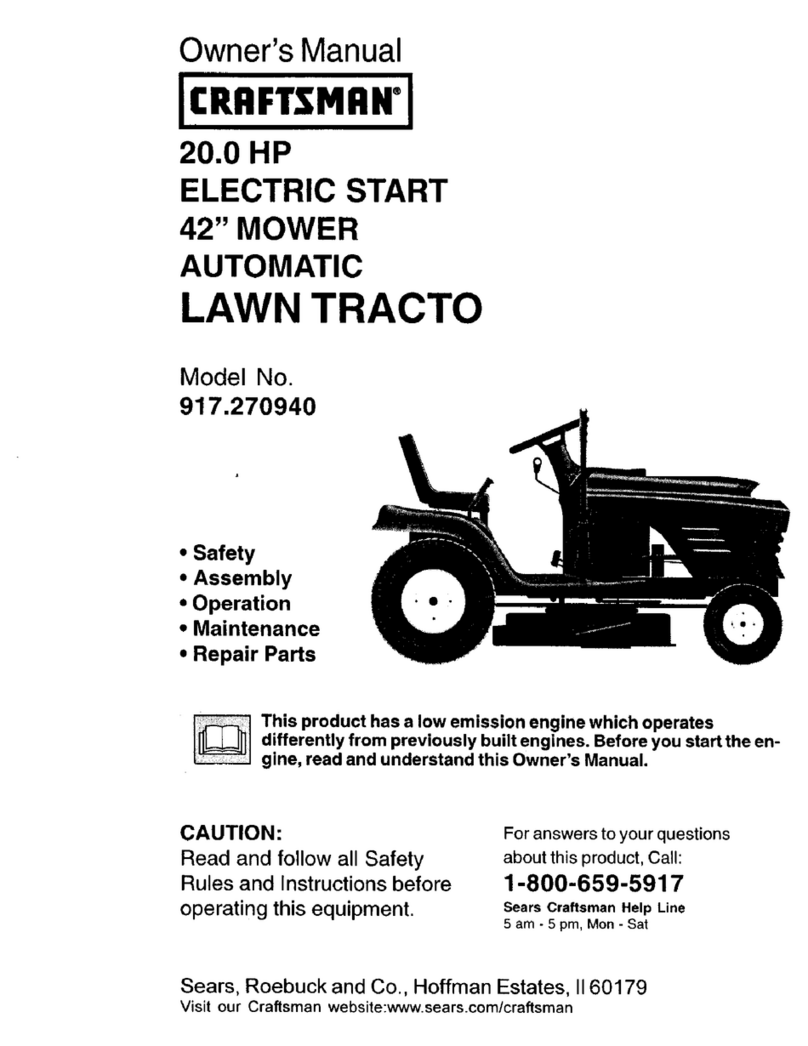
Crafstman
Crafstman 917.270940 User manual
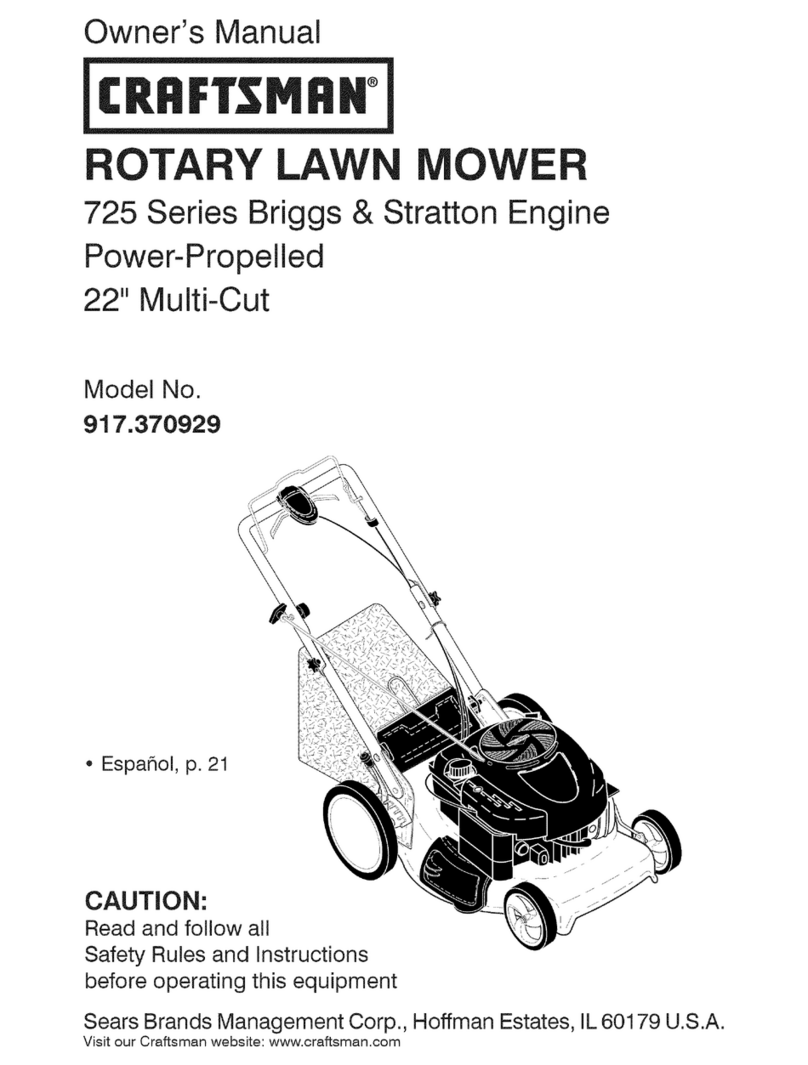
Crafstman
Crafstman 917.370929 User manual
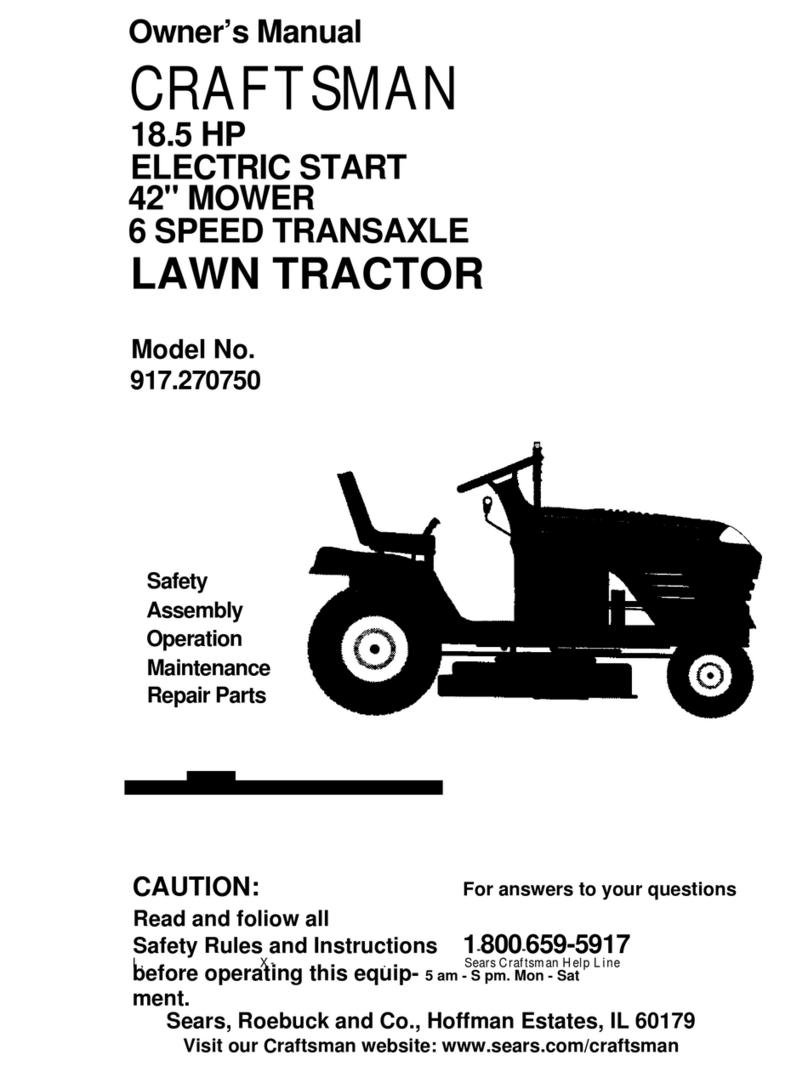
Crafstman
Crafstman 917.270750 User manual

Crafstman
Crafstman 917.255919 User manual
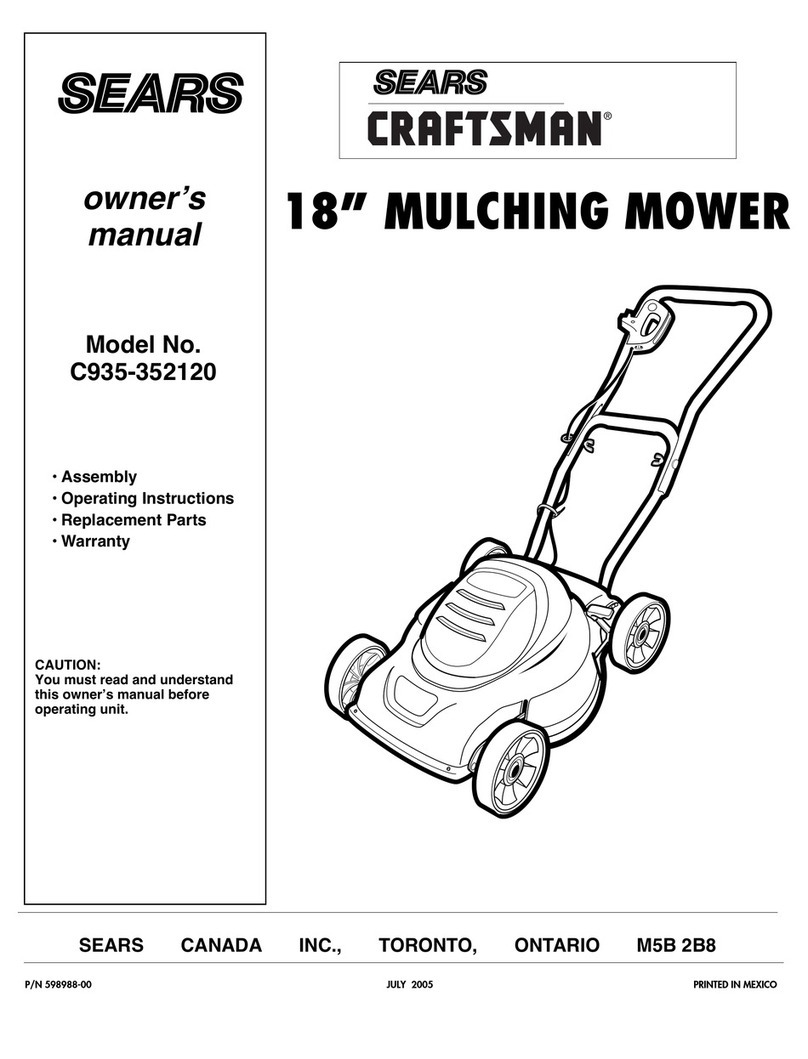
Crafstman
Crafstman C935-352120 User manual

Crafstman
Crafstman 917.25581 User manual
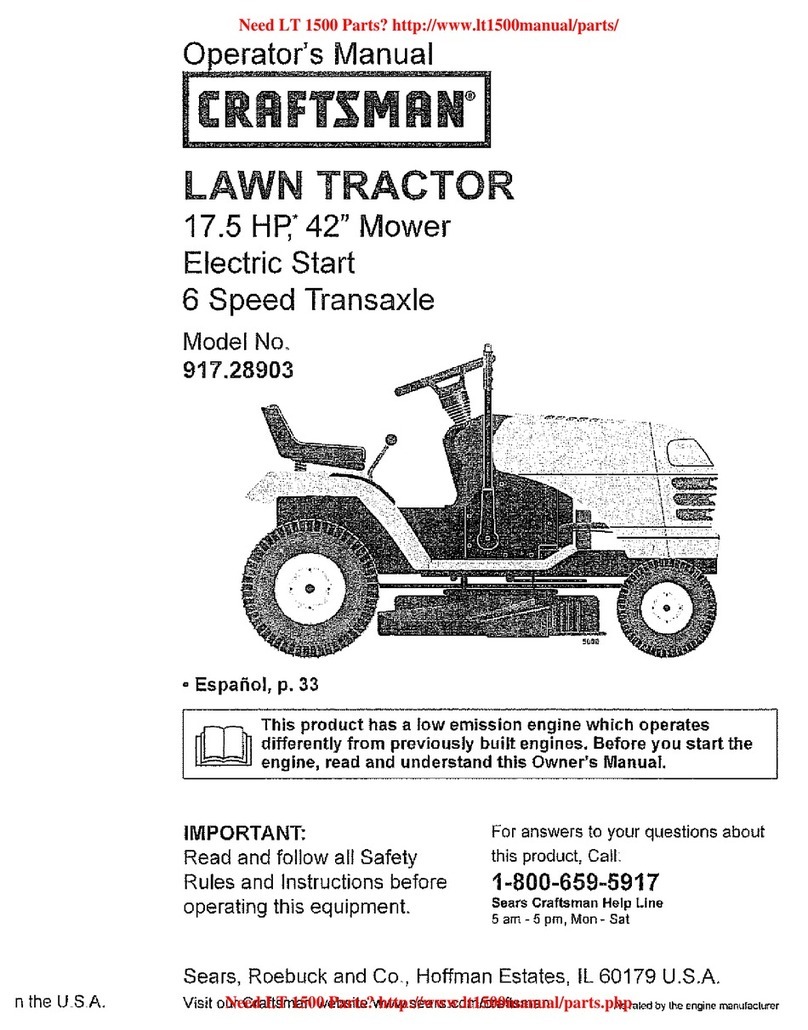
Crafstman
Crafstman lt 1500 User manual
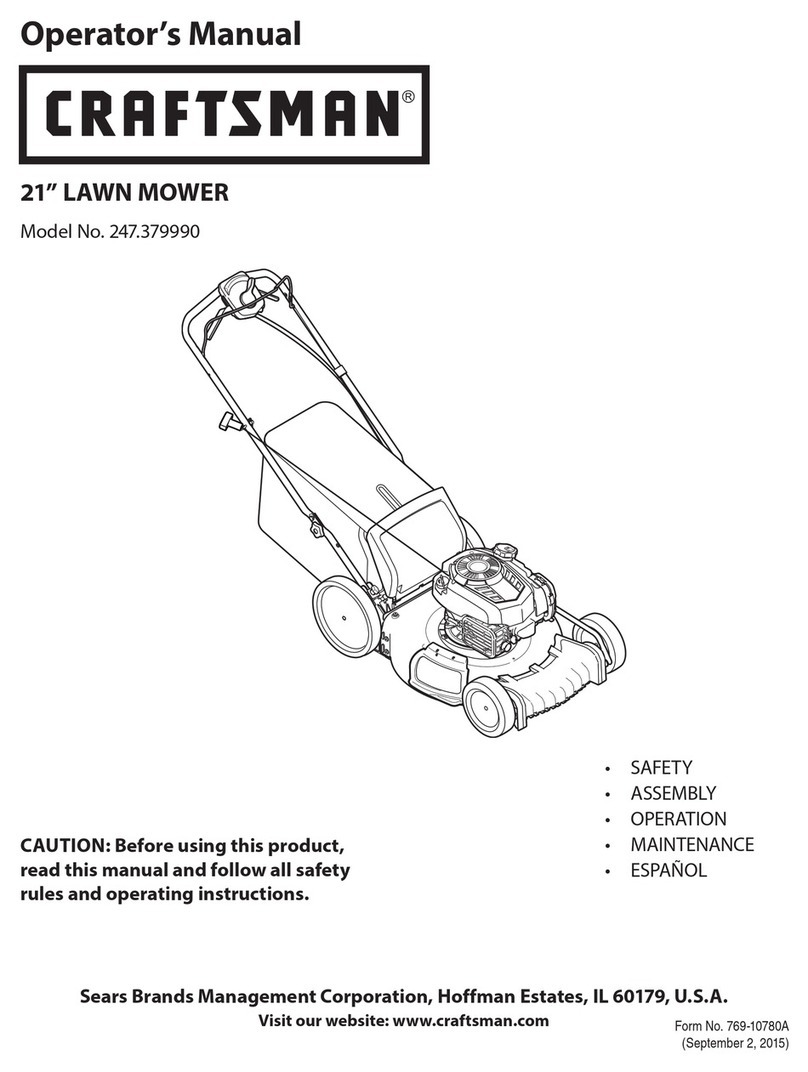
Crafstman
Crafstman 247.379990 User manual

Crafstman
Crafstman LT 2000 User manual
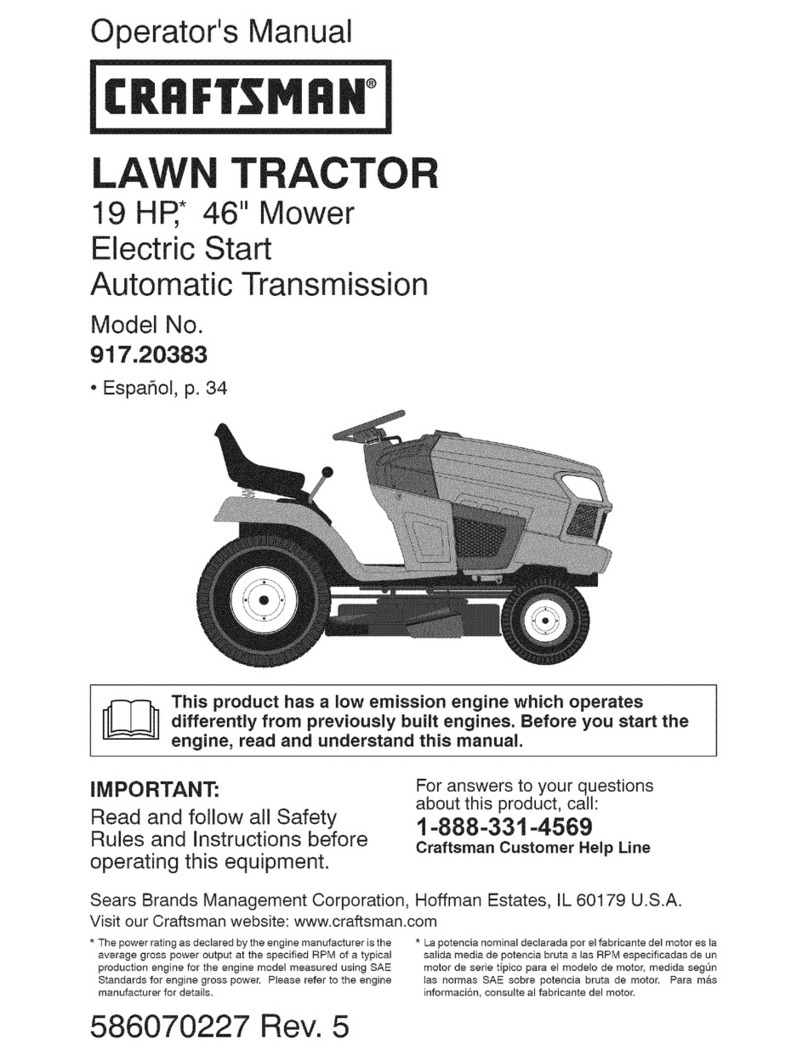
Crafstman
Crafstman 917.20383 User manual
